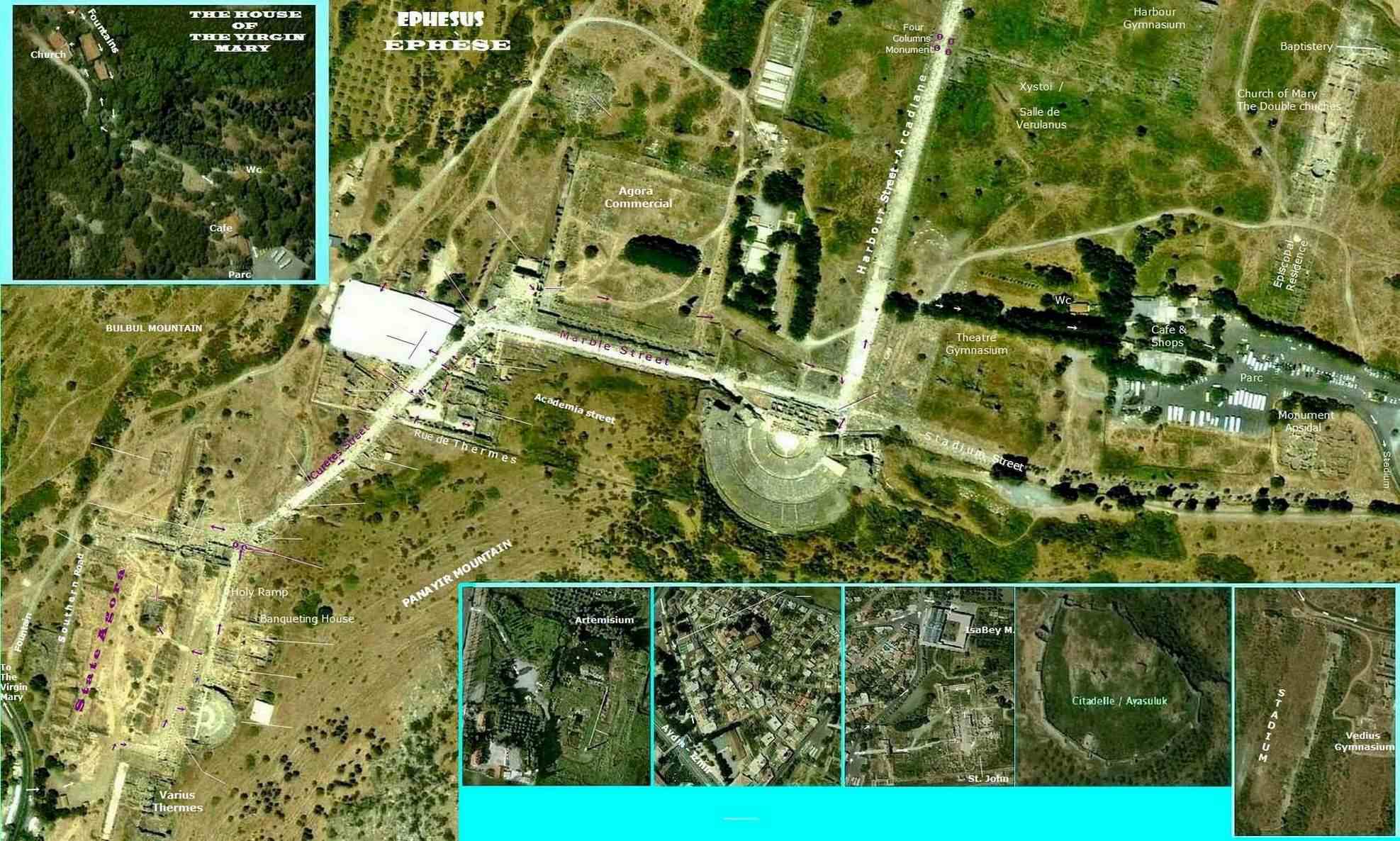
THE HERCULES GATE Located towards the end of the Curetes Street, it was called the hercules gate because of the relief of Hercules on it. It was brought from another place in the of the 4th or the beginning of the 5th century AD to its current place, but the relief on it dates back to the second century AD. This monumental gate was a two-storey building with six columns on each floor. Only the two side of the columns remain today and the other parts of it have not been found. A block adorned with a relief of Nike, the goddess of victory, now located a little further on, originally stood at this gate, which consists of two blocks of stone with a relief depicting the combat of Hercules and the Nemaean lion. On the terrace immediately to the left of the gate there is a four-columned Hellenistic fountain.It is also known by the name Victory Arch of Hercules. It is understood that the structure had collapsed at this point of the Curetes Street with the addition the stairs to the right and left,in 5th century, and the street had closed to car taffic. Heracles was the son of the affair Zeus had with the mortal woman Alcmene. Zeus made love to her after disguising himself as her husband. |
|---|
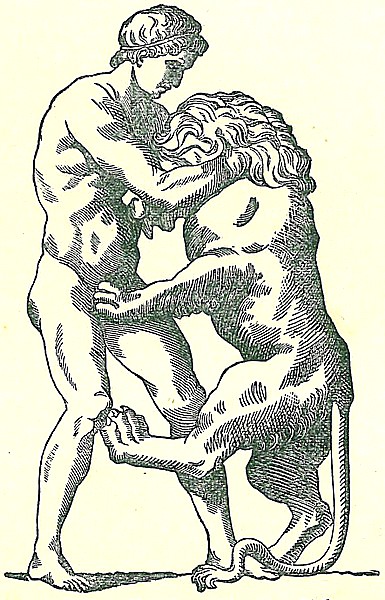 |
A few months after he was born, Hera sent two serpents to kill him as he lay in his cot. Heracles throttled a snake in each hand and was found by his nurse playing with their limp bodies as if they were child's toys.
After killing his music tutor Linus with a lyre, he was sent to tend cattle on a mountain by his foster father Amphitryon. Here, according to an allegorical parable, "The Choice of Heracles", invented by the sophist Prodicus (ca. 400 BC), he was visited by two nymphsPleasure and Virtuewho offered him a choice between a pleasant and easy life or a severe but glorious life: he chose the latter. Later in Thebes, Heracles married King Creon's daughter, Megara. In a fit of madness, induced by Hera, Heracles killed his children by Megara. After his madness had been cured with hellebore by Antikyreus, the founder of Antikyra, he realized what he had done and fled to the Oracle of Delphi. Unbeknownst to him, the Oracle was guided by Hera. |
|---|
He was directed to serve King Eurystheus for ten years and perform any task, which he required. Eurystheus decided to give Heracles ten labours but after completing them, he said he cheated and added two more, resulting in the Twelve Labors of Heracles. Driven mad by Hera, Heracles slew his own children. To expiate the crime, Heracles was required to carry out ten labors set by his archenemy, Eurystheus, who had become king in Heracles' place. If he succeeded, he would be purified of his sin and, as myth says, he would be granted immortality. The Twelve Labors of Heracles.1. To destroy the Lernaean Hydra.2. To capture the Ceryneian Hind.(Artemis's sacred animal)3. To capture the Erymanthian Boar.4. To clean the Augean Stables.5. To kill the Stymphalian Birds.6. To capture the Cretan Bull.7.To round up the Mares of Diomedes.8. To steal the Girdle of Hippolyte.9. To herd the Cattle of Geryon.10. To fetch the Apples of Hesperides.11. To capture Cerberus.12. To kill the Nemean lion. |
|---|
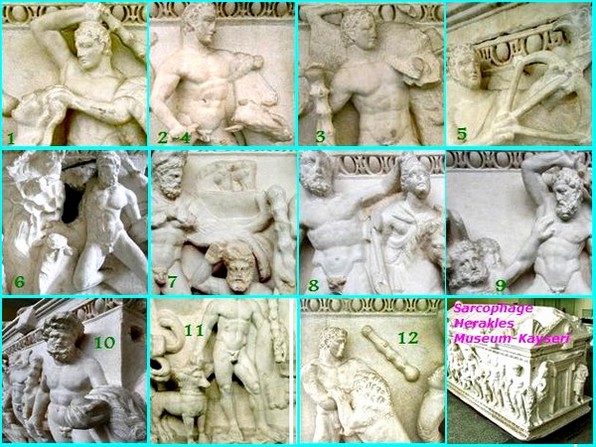 |
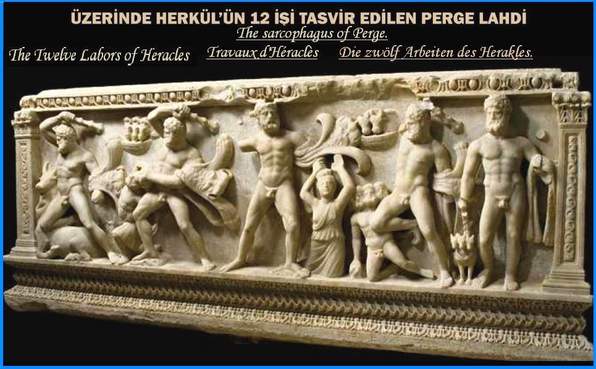 |
EPHESUS AMPHITHEATER This is the most magnificent structure in Ephesus ancient city. The Great Theatre is located on the slope of Panayir Hill, opposite the Harbor Street, and easily seen when entering from the south entrance to Ephesus.It was first constructed in the Hellenistic Period, in the third century (281 BC) during the reign of Lysimachos (Lysimachus is traditionally credited with building the theater, but so far there is no archaeological evidence for its existence before 100 BC. However, Lysimachus may have chosen the building site and begun the preparation of the site, a process that required 60 years of digging in the mountainside). |
|---|
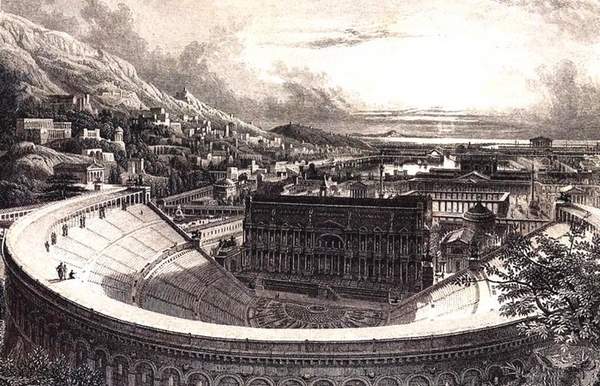 |
Then during the Roman Period (begun in the reign of the Emperor Claudius (A.D. 41-54) and completed in the reign of the Emperor Trajan (98-117 A.D.) , it was enlarged and formed its current style that is seen today.( it was expanded periodically and used continously until the 5th century.) Earthquakes damaged the theater in the 4th century, after which it was only partially repaired. By the 8th century, the theater was incorporated into the city defense system. Today, the theater is restored and is put to use every May during the Selçuk Ephesus Festival of Culture and Art. |
 |
|---|
 |
The stage building is three-storied and 18 meters high. The facade was richly decorated with columns, relieves and statues. The first two stories were built in the reign of Septimus Severus (193 - 211).There were ramps leading to the stage from the right and left and a staircase from the front. The columns which carried the marble floor of the stage are still to be seen. There were, at the front of the theater, three rows of columns and five doors with statues above them, opening to the orchestra area, the middle one of which is wider than the rest. This enhanced the appearance of the stage, giving it a bigger, monumental look. |
|---|
 |
|---|
It is the largest in Anatolia and has the capacity of 25,000 seats. The cavea has sixty six rows of seats (most of the them have been removed and used In the construction of later buildings), divided by two diazoma (walkway between seats) into three horizontal sections. In the lower section, Marble pieces, used for restoration, and the Emperor's Box were found. The seats with backs ,made of marble, were reserved for important people. The audience entered from the upper cavea. The theatre was used not only for concerts and plays, but also for religious (In early times the Great Theater was given over to the celebrations of the Festival of Artemis, protectress of the city, during the month of April. At this time 89 golden idols donated to the temple were brought to the theater in procession with singing and dancing, and plays were performed before a huge crowd of visitors) , political and philosophical discussions and for gladiator and animal fights. |
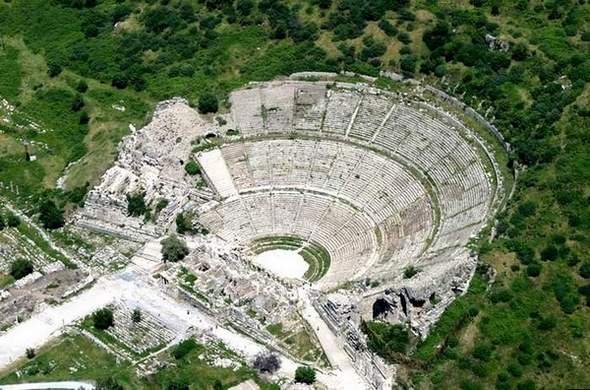 |
In the Bible In the 1st century AD, the Apostle Paul spent over three years in Ephesus preaching the Gospel. According to tradition,he delivered a sermon condemning pagan worship in this theater. And according to the Acts of the Apostles (19:23-41), the theater was the site of the "riot of the silversmiths" in which those who made silver figures of Artemis rioted because Paul's preaching was bad for business: Soon the whole city was in an uproar. The people seized Gaius and Aristarchus, Paul's traveling companions from Macedonia,and rushed as one man into the theater. Paul wanted to appear before the crowd, but the disciples would not let him. Even some of the officials of the province, friends of Paul, sent him a message begging him not to venture into the theater. The assembly was in confusion: Some were shouting one thing, some another. Most of the people did not even know why they were there...(Acts 19: 29 - 31) |
Efes Theater and St.Paul in video 24.36 - 24.60-35.35 |
Ephesus Terrace Houses Ephesus terrace houses are located on the hill, opposite the Hadrian Temple. Also called as "the houses of rich", important for the reason give us information about family life during the Roman period. They were built according to the Hippodamian plan of the city in which roads transected each other at right angels. There are six residential units on three terraces at the lower end of the slope of the Bulbul Mountain. The Slope Houses were used from the 1st century to 7th century AD, and then were abandoned. Around this time, after the devastating Arab raids and the continued silting up of the harbor, the remaining inhabitants of Ephesus moved to Ayasuluk hill (near the Basilica of St. John). After being abandoned, the Slope Houses gradually fell into decay. However, a number of them were filled with soil from landslips, which preserved them and their contents. |
|---|
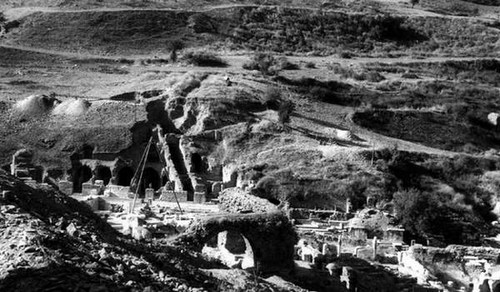 |
The houses at Ephesus are not inferior to those found at Pompeii and Herculaneum in terms of preservation and importance. Their decor and furnishings provide a great deal of information about the lifestyle of the Ephesian upper class in the Roman and Byzantine periods. |
|---|
The mosaics on the floor and the frescos have been consolidated and two houses have been opened to the public as a museum. They had interior courtyards (peristyle) in the center, with the ceiling open. They were mostly two-storied, upper stores have collapsed during time. On the ground floor there were living and dining rooms opening to the hall, and upstairs there were bedrooms and guest rooms. The heating system of the terrace houses were the same as that in baths. Clay pipes beneath the floors and behind the walls carried hot air through the houses. The houses also had cold and hot water. The rooms had no window, only illuminated with light coming from the open hall, so that most of the rooms were dim. The excavations of the terrace houses started in 1960. The restoration of the two of the houses have been finished and can be visited today. |
|---|
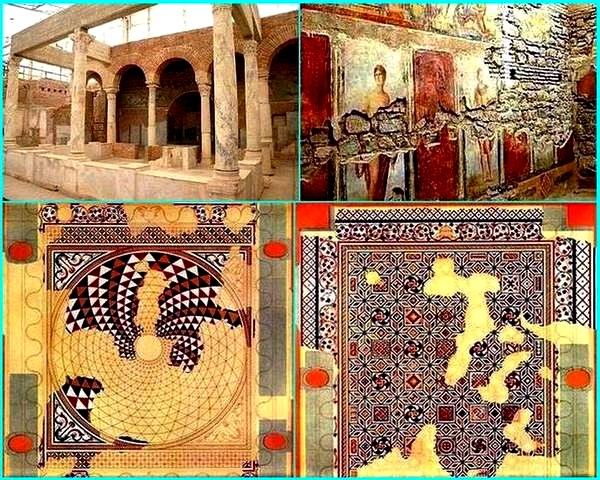 |
|---|
They are still being excavated and are sometimes covered by a tent, but are usually open to the public. They can be reached by a flight of steep steps from Curetes Street. The ruins have been divided by archaeologists into Slope House 1 (south) and Slope House 2 (north, closer to the Library). Each house had three stories, running water, heating, and an atrium with an entrance onto the side street. In Slope House 1, room A1 has a fine black-and-white mosaic. Room A2, the atrium, has a marble floor with the remains of a fountain in the center. The walls of rooms A10 and A11 are decorated with frescoes. The most interesting room in this house, though, is A3, dubbed the "theater room" based on the theatrical subjects of its frescoes. One of the owners of the house may well have overseen theater performances in Ephesus for a living. The right-hand wall has a scene from Menander's comedy, Perikeiromene ("The Girl Who Gets her Hair Cut"), and the left wall bears a scene from Euripides' Orestes. The room also contains a fine fresco of the mythological battle between Hercules and the river god Achelous for the hand of Deianeira. The shape-shifting Achelous assumed the form of a dragon and of a bull during the struggle, and only accepted defeat when Hercules tore off one of his horns. Slope House 2 is larger than its neighbor. Built in the 1st century AD, it was altered and extended several times before being abandoned in the 6th century. Many of its rooms feature mosaics and frescoes. Rooms B9 and B10 have frescoes of the muses. The house has two atria, the larger of which has several fine Corinthian columns lining a passageway paved with a beautiful mosaic of a triton and sea-nymph. |
|---|
The most interesting room in Slope House 2 is the atrium, because of a beautiful and unusual 5th-century glass mosaic in a niche. The niche is flanked by a decorative fresco of erotes supporting a garland. Inside the niche is a delicate glass mosaic of the heads of Dionysus and Ariadne against a background of luxuriant foliage and an array of glittering animals and birds. As the light changes, the glass tiles sparkle and glow, making the figures in the mosaic appear to move. The late date indicates the owners were likely Christians, making the pagan subject interesting.Some of the major finds from the Slope Houses can be see in the Ephesus Museum, rooms 1 and 3. |
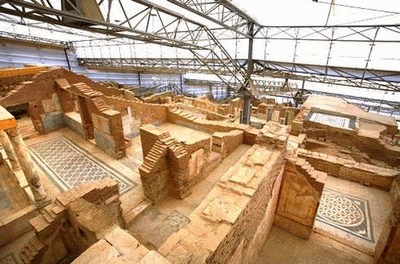 |
|---|
Terrace Houses in video 28.44 - 33.49->
Heroon It was a 2C BC U-shaped building with an open Ionic upper story. Water ran through a channel in front of the building. The gable and frieze had reliefs depicting Androclus killing a wild boar,the foundation story of Ephesus. The building is thought to have been a monument dedicated to Androclus. A heroon - was a shrine dedicated to an ancient Greek or Roman hero and was used for the commemoration or worship of the hero. It was often erected over his supposed tomb or cenotaph (a tomb or a monument erected in honor of a person or group of persons whose remains are elsewhere. It can also be the initial tomb for a person.) |
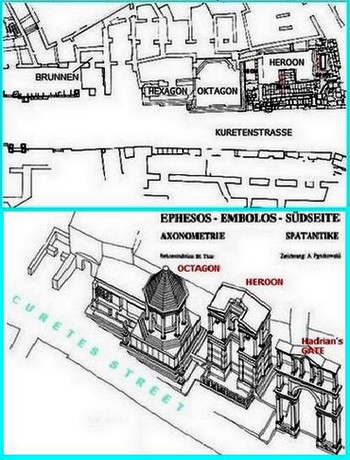 |
|---|
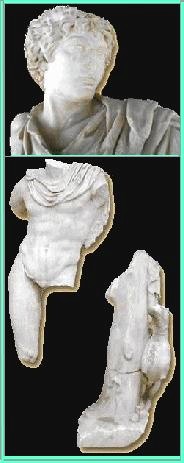 |
THE IONIAN BEGINNINGS The earliest inhabitants of Ephesus were the Lydians, the Lelegians and the Carians living on the north slope of the theatre hill. The base of the hill known today as Panayir Dagi, formally Mt Pion, was originally on the coast. The sea reached past the city and actually extended as far as the town of Selçuk. These early inhabitants worshipped the goddess Kybele and made their living from the land. The cult of Kybele and its sanctuary offered many attractions to the locals and to visitors. He was one of the sons of King Codrus (Kondros) of Athens. King Codrus was famous for his courage in war and his strong belief in the Delphic oracle. Just before his final battle he consulted the oracle and was: "The armies of the King who dies first will be the victors". Consequently, Codrus made sure that he was killed in the subsequent fighting. His death, while ensuring victory for the day, led to succession problems for Athens. Androclus and his stepbrothers, who were kings in the cities near Athens, ... It just so happened that, while Androclus was standing around deliberating, some local fishermen were getting down to the more practical business of cooking their lunch. |
|---|
They were cooking their catch of the day over an open fire when one of the fish with a burning ember attached to it fell off the grill, setting fire to the bush.The fire spread rapidly to some thickets where a wild boar had been fast asleep, and when it ran away, it was chased and eventually killed.The spot where it fell became the site for the temple of Athena and (somehow) the beginnings of Ephesus. An effigy of a wild boar was still to be found adorning the main street of the city as late as A.D.400. Ephesus prospered and eventually became one of the richest and most civilized cities of Western Anatolia Androclus died during a war with the Carians and was buried near the Magnesia Gate. A heroon (shrine dedicated to a deified person or hero) was built on the site as his descendants continued... | 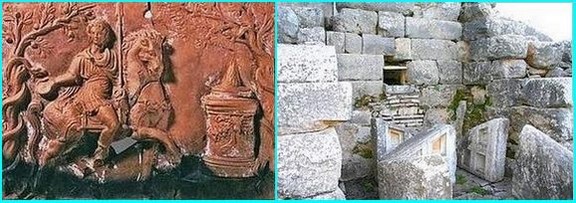 |
|---|
THE FOUNTAIN OF Gaius Laecanius Bassus (Hydrekdocheion) : On the southwest corner of the State Agora there are the remains of a fountain. According to an inscription the magnificent construction of this fountain was ordered by Gaius Laecanius Bassus in 80-82 AD. The facade of this fountain constructed by Bassus, one of the governor of Ephesus, was richly decorated, and consisted of two floors which faced the street. The statues of Tritons and Muses (sea creatures and river gods), which were found at the fountain, are now on display at the Ephesus Museum. Because of the enormous size of the fountain it has been referred to as the "Water Palace".This fountain is connected to another fountain which is located just opposite it to the west of the State Agora, and also at the same time to a storage cistern. The main section consists of a body in the form of a semicircle and was built in the 2nd century AD. The fountain building aligned with Domitian Lane and the terrace of the Temple of Domitian. The main basin was measuring 12.35 by 8.30 m, which served as a water reservoir, had the U-shaped aediculated facade. |
|---|
 |
The fountain underwent repairs in the reign of Constans and Constantius II (337-350) when the present wings were added. In inscriptions, this structure is referred to as the Nymphaion. It is the terminal point of the Aqueduct of Sextilius Pollio, which was built during the reign of Augustus between 7 -15 AD. The aqueduct was 3.5 kilometers long, and its remains may still be seen along the Selcuk-Aydin highway. There was a cistern in the upper part of the fountain, and the surroundings of the structure were decorated with statues of the Emperor. |
THE STATE AGORA: On the southern part of the Basilica is the State Agora, and was built in the Roman Period in the first century B.C. The agora is 160x73 meters, with stoas on three sides and an Isis temple in the center, dating from the 1st century A.D. This agora was used not for commerce but for business, it played an important role as a meeting place for the governmental discussions (it was the custom to hold all types of political activity (elections, meetings, demonstrations, etc) |
|---|
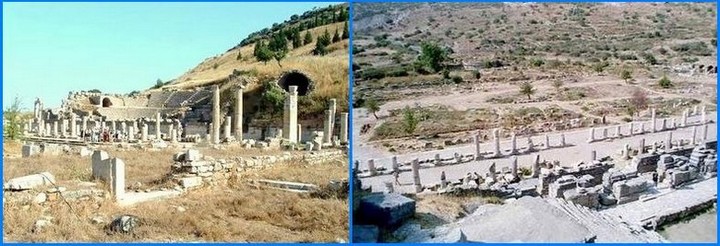 |
During the excavations in the northeast corner of the Agora were found a great number of graves from the 7th-6th centuries B.C and a stone-paved road, and a archaic sarcophagus of terra cotta. From this it is understood that in the archaic period this part of the Agora was used as the necropolis of Ephesus. There is a water reservoir at the corner of the Agora, which played an important role in Ephesus. Its water was brought to the city through the Pollio Aqueduct, the remains of the Pollio Aqueduct can be seen 5 kilometers away, along the Selçuk-Aydin highway. |
State Agora & Basilika & Pritaneum in video 19.00- 21.17-> |
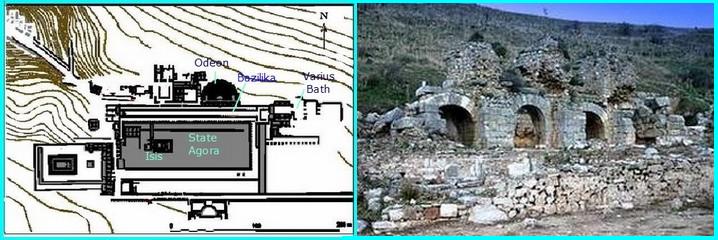 |
Bath of Varius The ruins to the east of the Basilica belong to the bath of Varius, dating to the Roman period. The construction dates to the 2nd century A.D and the mosaics in the 40 meters long corridor dates to the 5th century. It is built of cut blocks of marble. It has three sections, frigidarium (cold), tepidarium (warm) and caldarium (hot). The excavations have not been completed yet. |
 |
|---|
Basilika It is a typical Roman Basilica. It is 160 meters long, and located on the northern part of the state agora and has a nave and three-aisles. The Ionic columns in the basilica are adorned with bulls' head figures dating to the 1st century A.D.The basilica was used for stock exchange and commercial business. Meetings of the law courts were also held there in the basilica. It has three gates opening onto a stoa leading to the Bath of Varius. The statues of Augustus and his wife Livia were found at the east end, and now they are displayed in Ephesus Museum. So we can understand that the Basilica was rebuilt for the last time during the reign of the Emperor Agustus.It was destroyed by an earthquake in the middle of the Fourth Century AD. |
 |
ODEON This building has the shape of a small theatre with the stage building, seating places and the orchestra.It had double function in use. First it was used as a Bouleuterion for the meetings of the Boulea or the Senate. The second fuction was the Odeum as a concert hall for the performances.It was constructed in the 2nd century A.D by the order of Publius Vedius Antonius and his wife Flavia paiana, two wealthy citizens in Ephesus.It had a capacity of 1500 spectators. It had 3 doors opening from the stage to the podium. The podium was narrow and one meter higher than the orchestra section. The stage building was two-storeyed and embellished with columns.The podium in front of the stage building and some parts of the seating were restored. The Odeon used to be enclosed with a wooden roof. |
|---|
 |
Two councils administrated Ephesus. These were Demos or the parliament which was open to the public was taken place in the great theatre and the Bouleia which gathered in this small theatre. The members of the boulea were chosen from the aristocratic class of Ephesians. The most important decisions and city matters were discussed here. This building in the form of a small theatre was built in the 2nd century at around the same time and by the same people, namely Varius Antonius and his wife Flavia Papiona, as the baths beside it. It differs from the theatre in function, being used for meetings of the municipal council and concerts. It also differed from the theatre in being roofed by a wooden awning providing protection from sun and rain. It had seating for between 1500 and 2000. The first five tiers above the orchestra are original, with the stairs adorned with lion's paws in a very good state of preservation. An extraordinarily beautiful head of Eros found in the orchestra area is now exhibited in the Selcuk Museum. |
Nike There is an element of architecture triangular that bears a bas-relief of a Nike (Victory Dees) in flight, a wreath in hand. That block is from The Gate of Heracles. Nike is the goddess of victory in Greek mythology. She was the daughter of Styx and Pallas and the sister of Cratos, Bia, and Zelus. Nike and her brothers and sister were all friends of Zeus. Nike could run very fast, had wings and brings good luck. She is usually worshipped at the same time as Athena. Nike is often linked with sport, with companies named for her like Nike Inc. A picture of Nike also appears in all the medals for the Summer Olympics... |
|---|
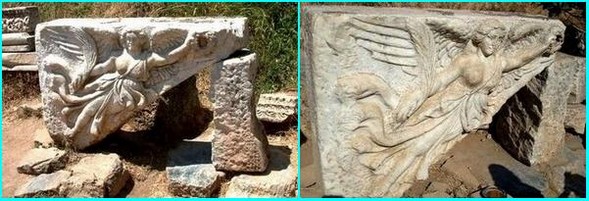 |
 |
CURETES STREET It is one of the three main streets of Ephesus between The Hercules Gate till to the Celsus Library.This street, 11m wide, took its name from the priests who were called as Curetes later.Their names were written in Prytaneion. There were fountains, monuments, statues and shops on the sides of the street. The shops on the south side were two-storied. Ephesus had many earthquakes, in which many structures including the Curetes Street were damaged. These damages especially on the columns were restored by the new ones, but after the earthquake in the 4th century, the columns were replaced by the other ones brought from different buildings in the city. The differences between the design of the columns can be seen today. The street has its appearance from the 4th century. |
|---|
 |
|---|
History Curetes Street originates in Hellenistic times, yet dramatically departs from the Hippodamian city grid plan that was popular at the time. Instead of running perpendicular to other streets, it cuts diagonally across the grid system. This unusual angle is due partly to the topographic limitations of the area ( Mount Pion), but it also follows the archaic Processional Way, an important sacred route leading to the Temple of Artemis. In Byzantine times, the road was known as the Embolos, meaning "beak" or "wedge." Archaeologists named it Curetes Street for an inscription that was found here naming the Curetes, or priests of Artemis. After an earthquake in the 4th century, many of the columns lining the street were replaced with those from other buildings in the city. |
The Temples of Dea Roma Divus Julius Caesar (Temenos) Dea Roma was a Roman era temple built between 4 -14 A.D. There used to be two temples between the Prytaneum (town hall) and Odeon (Concert hall). They were Imperial Cult erected in the 1C AD with the permission of Augustus in honor of his adoptive father Julius Caesar, and of Rome. The Imperial Cult never became a true religion.They aimed to have good relationship with emperors and flatter. There was an altar serving the worship of Artemis and Augustus. There were columns on both sides of the building. It was used mainly by Romans citizens of Ephesus. During the following ages, the temple was destroyed totally and some new buildings were built on top of it. During the excavations, the marble podium and the remnants of the side walls were revealed completely. |
|---|
THE ANCIENT CITY OF EPHESSUS Well-known from earliest times, this city was established on the delta of what is now called the Lesser Menderes River. The sheltered harbor of that period was the beginning of a royal road the ended at the gate of Susa, the capital of the Persian Empire, which secured the city its importance. The oldest finds are from the Neolithic Age dated 6000 years before Christ, found at the Çukuriçi Höyük. There was a Hittite settlement on top of Ayasuluk Hill from the Old Bronze Age. The name was then Apasus, according to Hittite inscriptions found there. Linguists believe the name Ephesus came from this Hittite name. According to the old legends, Ephesus was founded by the female warriors known as the Amazons. The name of the city is thought to have been derived from "APASAS", the name of a city in the "KINGDOM OF ARZAWA" meaning the "city of the Mother Goddess". Ephesus was inhabited from the end of the Bronze Age onwards, but changed its location several times in the course of its long history in accordance with habits and requirements. Carians and Lelegians are to be have been among the city's first inhabitants. Ionian migrations are said to have begun in around 1200 B.C. According to legend, the city was founded for the second time by Androclus, the son of Codrus, king of Athens, on the shore at the point where the CAYSTER (Küçük Menderes) empties into the sea, a location to which they had been guided by a fish and a wild boar on the advice of the soothsayers. The Ionian cities that grew up in the wake of the Ionian migrations joined in a confederacy under the leadership of Ephesus. According to Herodotus, the colonists gave the name Artemis to the mother goddess Kybele. The temple to Artemis from that period became one of the Seven Wonders of the Ancient World. The region was devastated during the Cimmerian invasion at the beginning of the 7th century B.C. The city was attacked successively by the Lydians in 560 BC and under the rule of the Lydian kings, Ephesus became one of the wealthiest cities in the Mediterranean world. The defeat of the Lydian King Croesus by Cyrus, the King of Persia, prepared the way for the extension of Persian hegemony over the whole of the Aegean coastal region. At the beginning of the 5th century, when the Ionian cities rebelled against Persia, Ephesus quickly dissociated itself from the others, thus escaping destruction. Ephesus remained under Persian rule until the arrival of Alexander the Great in 334 B.C., when it entered upon a fifty year period of peace and tranquillity. Lysimachus, who had been one of the twelve generals of Alexander the Great and became ruler of the region on Alexander's death, decided to embark upon the development of the city, which he called Arsineia after his wife Arsinoe. Based upon finds from this latest time, he set up his city based upon the "Gridiron Plan" found in the Miletus Hippodrome. The streets thus intersected one another in a regular pattern. He constructed a new harbour and built defence walls on the slopes of the Panayır and Bülbül Mts., moving the whole city 2.5 km to the south-west. Realising, however, that the Ephesians were unwilling to leave their old city, he had the whole sewage system blocked up during a great storm, making the houses uninhabitable and forcing the inhabitants to move. In 281 B.C. the city was re-founded under the old name of Ephesus and became one of the most important of the commercial ports in the Mediterranean. In 129 B.C. the Romans took advantage of the terms of the will left by Attalos, King of Pergamon, by which they were bequathed his kingdom, to incorporate the whole region into the Roman Empire as the province of Asia. Ancient sources show that at this time the city had a population of 200,000. In the 1st century B.C. the heavy taxes imposed by the Roman government led the population to embrace Mithridates as their savior and to support him in his mutiny against Roman authority and in 88 B.C. a massacre was carried out of all the Latin speaking inhabitants of the city, which was then stormed and sacked by a Roman army under Sulla, It was from the reign of Augustus onwards that the buildings we admire today were constructed. According to documentary sources, the city suffered severe damage in an earthquake in 17 A.D. After that, however, Ephesus became a very important centre of trade and commerce. The historian Aristio describes Ephesus as being recognised by all the inhabitants of the region as the most important trading centre in Asia. It was also the leading political and intellectual centre, with the second school of philosophy in the Aegean. From the 1st century onwards, Ephesus was visited by Christian disciples attempting to spread the Christian belief in a single God and thus forced to seek refuge from Roman persecution. Besides enjoying a privileged position between East and West coupled with an exceptionally fine climate, the city owed its importance to its being the centre of the cult of Artemis. Under Roman rule the city became the largest and richest in the province of Asia thanks to both land and sea trade. There were marble monuments everywhere in the city. It was the first city built entirely out of marble. In the 4th century AD trade had declined because the harbor was silting in. The Emperor Hadrian had the harbor dredged several times. The harbor was finned in by silt from the Marnas River and the Lesser Menderes coming from the north. In time the city was increasingly distant from the sea. For the Christians, the city, with its highly advanced way of life, its high standard of living, the variety of its demographic composition and its firmly rooted polytheistic culture, must have presented itself as an ideal pilot region... From written sources we learn that St Paul remained in the city for three years from 65 to 68, and that it was here that he preached his famous sermons calling upon the hearers to embrace the faith in. one God. He taught that God had no need of a house made with human hands and that he was present in all places at all times. This was all greatly resented by the craftsmen who had amassed great wealth from their production of statues of Artemis in gold, silver or other materials. A silversmith by the name of Demetrius stirred up the people and led a crowd of thousands of Ephesians to the theatre, where they booed and stoned Paul and his two colleagues, chanting "Great is Artemis of the Ephesians! Great is Artemis of the Ephesians!" So turbulent was the crowd that Paul and his companions escaped only with great difficulty. From his Epistles to the communities it would appear that Paul spent some time as a prisoner in Ephesus. Legend has it that St John the Evangelist came to Ephesus with the Virgin Mary in his care. Some also say that it was here that he wrote his Gospel and was finally buried. In 269 Ephesus and the surrounding country was devastated by the Goths. At that time there was still a temple in which the cult of Artemis was practised. In 381, by order of the Emperor Theodosius, the temple was closed down, and in the following centuries it lay completely abandoned, serving as a quarry for building materials. The situation of the city, which had given it its privileged geographical position, was also the cause of its decline and fall. The prosperity of the city had been based on its possession of a sheltered natural harbour, but by the Roman period ships reached the harbour to the west of Mt Pion 1.5 km from the Temple of Artemis through a very narrow and difficult channel. The cause of this was the Meander (Cayster) River, which emptied into the Aegean a little to the west of the city of Ephesus, where it created a delta formed by the alluvium carried down by the river over thousands of years. By the late Byzantine era the channel had been so silted up as to be no longer usable. The sea gradually receded farther and farther, while the marshy lands around the harbour gave rise to a number of diseases, such as malaria. The new outlook that had arisen with the spread of Christianity led to the gradual abandonment of all buildings bearing witness to the existence of polytheistic cults and the construction in their place of Christian churches. In the year 431 the third Ecumenical council took place in Ephesus. Emperor Theodosius convoked another council in Ephesus in 449, which came to be known as the "robber council". From the 6th century onwards the Church of St John was an important place of pilgrimage, and Justinian took measures to protect it by having.the whole hill on which it stood surrounded by defence walls. There is much information in the bible about the church at Ephesus. The church at Ephesus was founded by Paul where he reasoned with the Jews, he left Priscilla and Aquila there (Acts 18:19). Paul came back to Ephesus and found some disciples who had not received the Holy Spirit, they had only been baptised into John's baptism, when they were baptised in the name of the Lord Jesus the Holy Spirit came upon them (Acts 19:1-7). Paul spoke in the synagogue for three months (Acts 19:8) and then in the lecture hall of Tyrannus for 2 years (Acts 19:9-10). Then there was a disturbance because of the fertility goddess Artemis who brought the Ephesians wealth through making silver images of her (Acts 19:23), they were afraid that through Paul's preaching about Christ they would lose business. Paul left Timothy at Ephesus (1 Tim 1:3). He said good-bye to the elders of Ephesus at Miletus before going to Jerusalem (Acts 20:17-38) where he warned them that savage wolves will come in among them (Acts 20:29). He also wrote to the Ephesians a long letter from which it is clear that they were a mature church. It is also thought that the apostle John and Mary, Jesus mother, settled at Ephesus. Some two-and-a-half centuries after Paul preached in Ephesus, the city hall was converted into a church and later used by the Council of Ephesus, which in 431 AD formally accepted the teaching that Jesus was both fully human and fully divine (C Hill, Prophecy Today, Vol. 11, No 5. p 26-27.). Shortly afterwards, the Church of the Virgin and other places of worship were destroyed and pillaged in Arab raids. In the 7th century the city was transferred, for better defense to the site now occupied by the town of Selçuk and during the Byzantine era Ephesus grew up around the summit of Mt Ayasuluğ. The city enjoyed its last years of prosperity under the Selçuk Emirate of the Aydınoğulları. During the Middle Ages the city ceased to function as a port. When the Turks came in the 13th century Ephesus was just a small village. They built mosques, caravanserais, and baths typical of Turkish civilization.By the 20th century the silt carried down by the Meander had extended the plain for a distance of 5 km. |
|---|
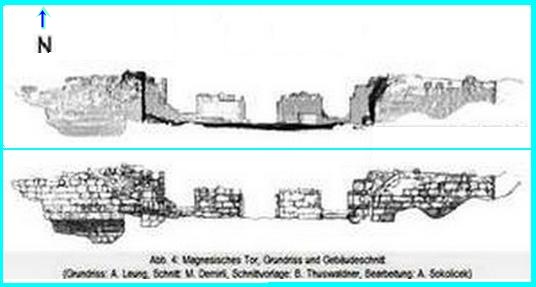 |
The Magnesian Gate : There were three entrances to Ephesus; The Magnesian Gate , the Koressos Gate (at the back of the Stadium) and the harbor. Magnesian Gate erected during the reign of Vespasian (69-79), in the form of a victory arch, this marks the beginning of the city walls surrounding the Panayir and Bulbul hills,on the road the house of Mother Mary. This is one of the three entrances into the city. The road that led out of this gate would have connected travelers to Magnesia or Miletus. |
Tempel of DOMITIAN [A member of the Flavian dynasty, Domitian became Emperor in 81 A.D. At first an honest administrator he later became an tyrannical despot, proclaiming himself "Lord and God" (Dominus et Deus). Assassinated with the connivance of his wife Domitia, his memory was damned by decree of the senate (Damnatio memoriae) and all his statues destroyed. Erected on a pro-style plan with 8 x 13 columns, it was one of the largest temples in the city. A colossal statue was discovered here consisting of an arm with clenched fist made from a single piece of marble and a very well-preserved head. The temple and statue in Ephesus are of particularly great importance in view of the very few remains connected with Domitian.] Located to the south end of the Domitian Street, it is the first structure in Ephesus known to be dedicated to an emperor(81 - 96A.D.). It was built on a high and wide terrace set by 50x100 meters in size, on vaulted foundations. The northern size of the terrace seems to be two-stories high, reached by stairs. The stairs are still visible today. |
|---|
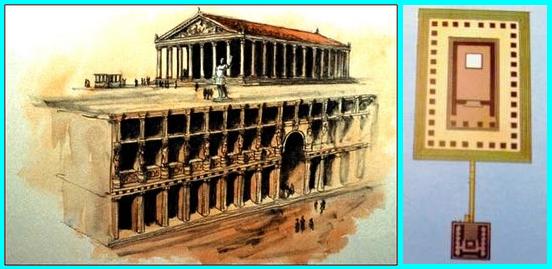 |
The temple had eight columns on the short side and thirteen columns on the long side, and four additional columns in front of the cella. At the northern side there was an u-shaped altar, which is now displayed in Ephessus and Izmir museums. |
|---|
The emperor's colossal statue stood on the top of this terrace. The statue is now also in the Archaeological Museum at lzmir. The heaps of broken carved pieces lying all over the courtyard were found as they stand now, during the excavations. It was in the reign of Domitian that an emperor gave permission to built an Emperor Temple; that is the permission to be the 'neocoros' for the first time, which was a great honor for a city. When the unpopular emperor was killed by his servant, public quickly took vengeance and erased his name from many inscriptions. However in order to not lose its neocoros status , the Ephesians re-dedicated the temple to Vespasian, the father of Domitian. |
|---|
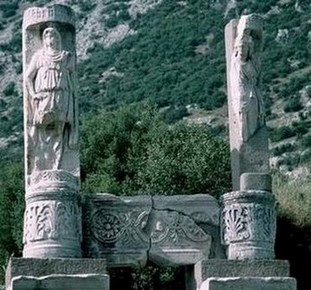 |
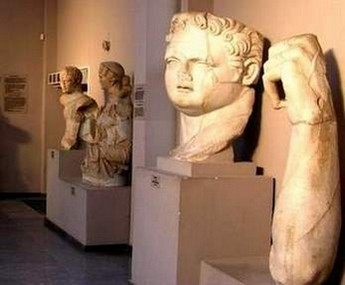 |
|---|
Domitian Temple in video 25.56- 26.43->
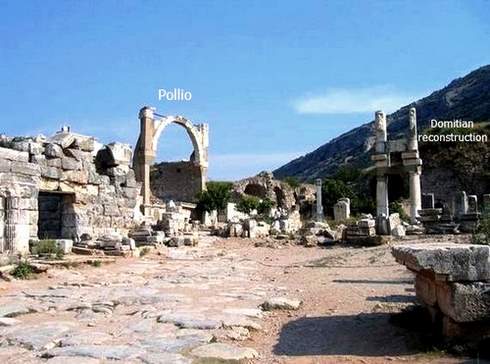 |
|---|
| The west side of the square of Domitian was not searched. The monument circle which in the middle of the square is from another part of the city and , in the IVth century, has been placed there without a care . The exterior of the monument is decorated with bulls' heads crowned with garlands. |
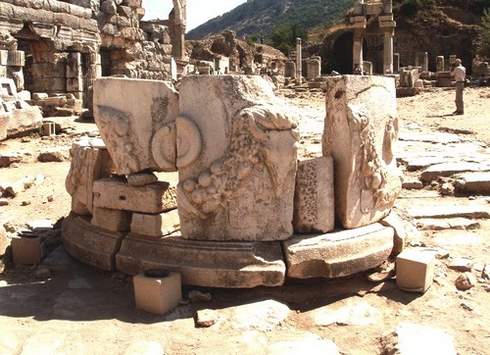 |
HEXAGON-NYPHEUM : A hexagonal fountain on the left side of the Octagon Monument. |
THE OCTAGON (27 B.C.-14 A.D.) Tomb of the Ptolemaic Arsinoe IV |
|---|
 |
It was a vaulted burial chamber placed on a rectangular base with the skeleton of a 15 or 16 year old woman in a marble sarcophagus. According to an interpretation Octagon was a monument to Ptolemy Arsinoe IV, the youngest sister of the famous Cleopatra VII, was murdered in Ephesus in 41 BC. Arsinoe IV (ca. 68/67 41 BC) was the fourth daughter of Ptolemy XII Auletes, sister of Ptolemy XIII and Cleopatra VII, and one of the last rulers of the Ptolemaic dynasty of ancient Egypt. When their father died, he left Ptolemy and Cleopatra as joint rulers of Egypt, but Ptolemy soon dethroned Cleopatra and forced her to flee Alexandria. |
|---|
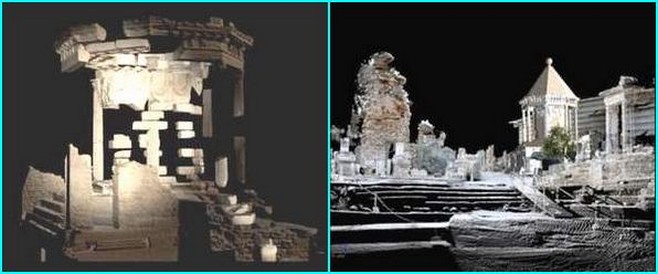 |
|---|
When Julius Caesar arrived in Alexandria in 48 BC and sided with Cleopatra's faction, Arsinoe escaped from the capital with her mentor Ganymedes and joined the Egyptian army under Achillas, assuming the title of pharaoh. When Achillas and Ganymedes clashed, Arsinoe had Achillas executed and placed Ganymedes in command of the army. Ganymedes initially enjoyed some success against the Romans, negotiating an exchange of Arsinoe for Ptolemy, but the Romans soon received reinforcements and inflicted a decisive defeat on the Egyptians. Arsinoe was transported to Rome, where she was forced to appear in Caesar's triumph. Despite usual traditions of prisoners in triumphs being strangled when the festivities were at an end, Caesar spared Arsinoe and granted her sanctuary at Ephesus. Arsinoe lived in the temple for many years, always keeping a watchful eye for her sister Cleopatra, who saw her as a threat to her power. Her fears proved well-founded; in 41 BC, at Cleopatra's instigation, Mark Antony ordered her executed on the steps of the temple. She was given an honorable funeral and a modest tomb. |
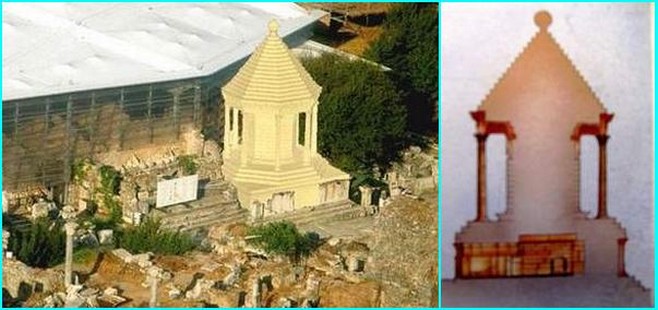 |
|---|
Sarcophage & Viyana Ephessus museum in video 16.00 - 18.10->
citadel of Ayasuluk : The well preserved Byzantine castle stands on the hill of Ayasuluk during 1500 years. As the castle was located at significant point it was rebuilt and expanded in the Seljukian and Ottoman eras. The main entrance gate of the castle was constructed from the stones of Roman buildings in the 6th century AD. The castle has 15 towers and is surrounded by rubble stoned city walls reaching to 1.5 km. A church, -built into a former Byzantine church, a small mosque (14th century A.D.) and several cisterns are within the borders of the citadel of Ayasuluk. Also, it was proved from the remaining of sub-mycenean graves belonging to 14th century BC, that the hill was used as a necropolis. It is built in the Byzantine period and expanded by the Seljukians. The citidal has 15 towers approximately in the length of 1.5 km and surrounded by the stone ramparts. The citidal also includes the remains of a Byzantine church, a small mosque and several water cisterns. |
|---|
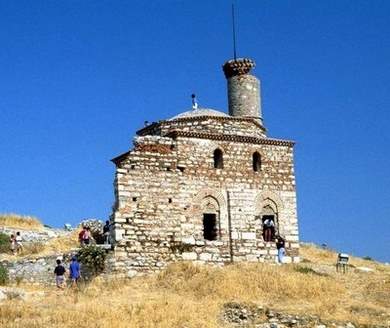 |
Kale Camii mosque (14th century A.D.) has a square shape and a dome with a tholobate (drum). To the east is a minaret. |
The Stadium was located to the south of the Vedius Gymnasium. The spectators' seats on the south was resting on the slopes of the Mount Pion (Panayirdag). The seats on the northern section were placed on the heightened vaulted galleries. There was a monumental entrance gate to the Stadium on the west. Its last shape was mainly given and enlarged during the Roman Emperor Neron's reign in the 1st century A.D. As all Roman stadiums from the classical era, it was planned in a U-shape then. But none of the pieces of seating tiers were kept. They were used the restorations of the other buildings in Ephesus and also in the construction of the Basilica of St. John. It was first built in the Hellenistic Age. It was purely used for ceremonies and sports activities. But during the 3rd and 4th centuries other than the sports activities and ceremonies, gladiator and wild animal fights became very popular especially in Roman Period. It is known that certain families, such as the Vedius, owned gladiator schools.Also Christians were persecuted here and were thrown to the lions. So when Christianity became the official religion of Romans in 413 AD. they destroyed it and built the Persecution Gate also as a symbol of these sufferings. |
|---|
 |
Vedius Gymnasium It is easily seen when entering the Ephesus city from the south entrance. The construction of the gymnasium dates around the second century AD, funded by Publius Vedius Antoninus and his wife Flavia Papiana. They dedicated the gymnasium to Goddess Artemis and to Emperor Antoninus Pius. In Ephesus, gymnasiums were the schools for young people in which one could take lessons for art, sports, literature, drama and speech. The most important and beautiful of these gymnasiums was the Gymnasium of Vedius. The entrance of the gymnasium is on the east, and when entering there is a palaestra (courtyard), surrounded by columns. The hall of emperors is also on the east, with statues and floors covered with mosaics. The gymnasium included a bath, with a tepidarium, a caldarium, and a frigidarium. There was a pool at the frigidarium, with the statue of the god of the River Kaistros in the north end, pouring water into the pool from the amphora that the god was leaning on. Today, the statute is displayed in Izmir Museum. |
THE GATE OF MAZEUS And MYTHRIDATES - GATE OF AUGUSTUS (4-3 B.C.) The gate with three passage ways at the right of the Celsus Library was built by the slaves Mazeus and Mythridates for their emperor, Augustus, who gave them their freedom. The passages are vaulted, the front side of the vault facing the Celsus Library is made of black marble, while the other side is white. |
|---|
 |
| A Latin inscription with inlaid letters made of bronze is still visible on one side of the structure. Part of the inscription states: "From the Emperor Caesar Augustus, the son of the god, the greatest of the priests, who was consul twelve and tribune twenty times; and the wife of August Livia; the son of Lucus, Marc Agrippa who was consul three times, Emperor, and tribune six times; and the daughter of Julio Caesar Augustus, Mazeus and Mythridates to their master and the people." The small area in front of the gate was used as an auditorium. The steps around the gate, in front of the library and the round pedestal were used as seats. In Byzantine Period, the walls in the small area were built when the city walls were reduced in length. |
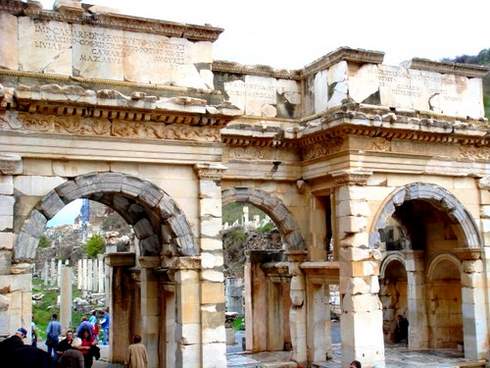 Augustus Gate in video 18.30 and 22.12-> |
FOUNTAIN OF POLLIO The Polio Fountain was situated on its left side of the temple of Domitian. It was built in 97 A.D by the rich Ephesian C.Sextilius Pollio and his family. The water was brought to the fountains of Ephesus from three main sources through aqueducts and distributed from fountains by a branching system of baked clay pipes. The sources were Kencherios (42km) at Kuşadası, Çamlık village stream of Marnas (15km), and the Cayster River (20km).Water was free of charge by the city in the public fountains. Also they provided refreshment in hot summer days for the streets. Richly decorated sculpture from the Hellenistic period was excavated there. It has a high arch facing the temple of Domitian. It is decorated with a number of statues. One of these statues is the Head of Zeus which is on display in the Ephesus Museum today. Some of these statues were thought to be taken from the Isis Temple, probably after an earthquake, to repair the fountain. The sculpture depicts Odysseus while he was blinding Polyphemus (cyclops) in order to escape from his cave, that once were on the basin, are now displayed also in Ephesus Museum. |
|---|
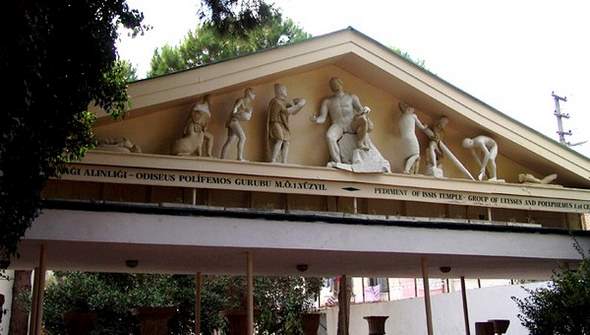 |
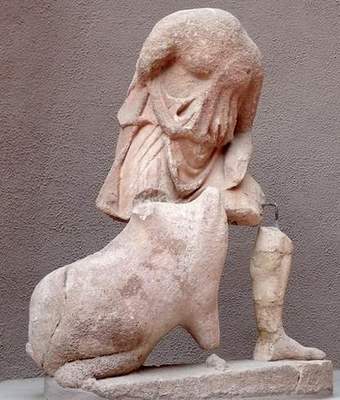 |

Arcadian Street (Harbor Street) This street is situated between the Harbour Baths and the great theatre. Entering from the port, traders and sailors would first arrive in this street. So it was designed gorgeous with marbel slabs and colonnades. It was constructed in the Hellenistic Period, but then was restored during the reign of the Emperor Arcadius (395 - 408 AD), from whom it takes its present name. |
|---|
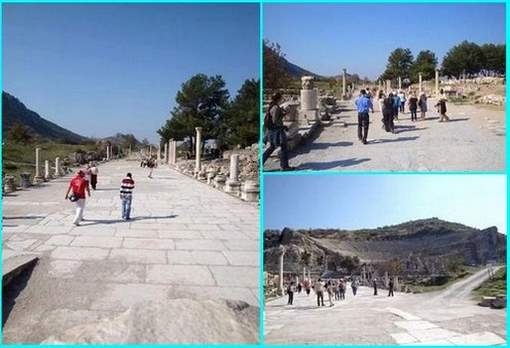 |
The street was 530 meters long and 11 meters wide, and on both sides of the street there were shops and galleries, and gates in the form of monumental arches. There were four higher columns with the statues of four apostels on the top. It was one of the three lighted street at that time along with Rome and Antioch.50 streetlights lit up its colonnades and water, sewerage channels ran beneath the marble flagstones. "Four Apostles Monument" with four columns, each with a statue of one of the Apostles was located in the middle of Arcadiane Street. |
 |
At the entrance of the port there were the Port Baths or the Harbour Baths.They were built in the year 2 AD.The Baths are also called the Baths of Constantine, for they were restored by Constantine II (337-361). It was one of the largest building with 160 m wide, 170 m long and 28 m high... |
|---|
The Mythology of Asklepios The Snake Cult During the Roman Empire there was a large medical school in Ephesus. The medical tools can be seen house findings hall in the museum of Ephesus. The symbol of the hospitals in antiquity was the snake on a staff. As in Biblical times looking to the snake on the staff of Moses brought healing, they used the same symbol.However they symbolized the god Asklepios. |
|---|
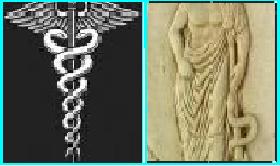 |
 |
|---|
Asklepios was the god of health, medice and physicians. He was the son of the sun god Apollo. Apollo had a mortal lover, Koronis. Apollo, as was his duty, carrying the sun from the east to the west was able to see everything on earth as he was on the Mountain of Olympia. One day Koronis betrayed him. So Apollo saw it and killed her with a thunderbolt. But he remembered that she was pregnant. He came to the earth and saved the baby from her womb.The baby was called Asklepios. Apollo gave him to the horse Chiron. He taught Asklepios every secrets of healing. Even he became so wise to raise the dead. The God of underworld and deaths was so nervous and complaint about him to Zeus. Zeus had to kill Asklepios when he was working on a formula.On that rainy that the formula went into the earth and grew the useful garlic as a remedy of many sickness. Asklepions were the only hospitals of the ancient times. |
|---|
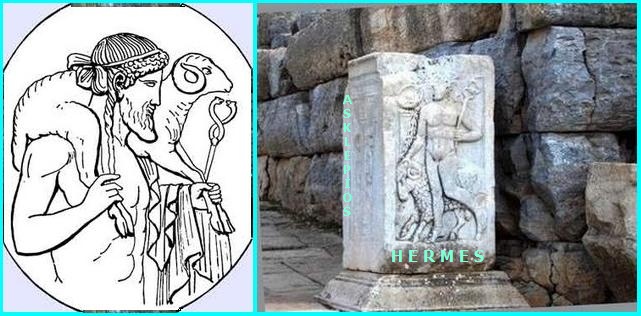 |
|---|
The Mythology of Hermes In Ephesus one of the hermes, stood on the corner at Domitian Square, was depicted with his heralds staff and winged sandals. Hermes (Messenger of the gods, god of commerce, thieves, travelers, sports, and border crossings ) was the herald god for the Olympians. He was the son of Zeus and Maia. He was the safeguard of trade roads as a god of traders, merchants. He was well-known for his cunning and shrewdness. He stole the cattle of Apollo and offered his invention lyre in exchange for them. So Hermes used a heralds staff from Apollo as the god of shepherds. One of his duty was to guide the souls of the dead down to the underworld. He was also closely connected with bringing dreams to mortals. Hermes was usually depicted with a broad-brimmed hat or a winged cap, winged sandals and the heralds staff (kerykeion in Greek, or Caduceus in Latin). The clothes he wore, were usually that of a traveler, or that of a workman or shepherd. Other symbols of Hermes are the cock, tortoise and purse or pouch. |
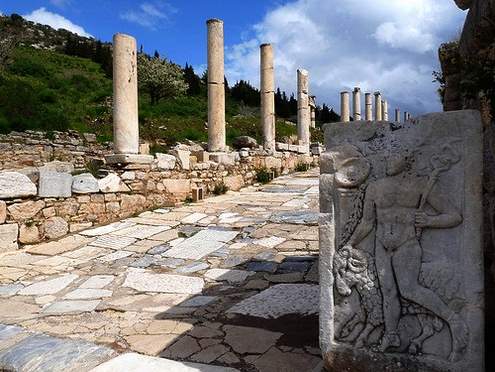 |
Hermes was the patron of roads and boundaries. His name came from herma, was a square or rectangular pillar in either stone or bronze with the head of Hermes and usually with a beard, was used for roads as boundary markers. Also in Athens they used hermas outside of the houses to keep themselves from evil. It was Hermes who liberated Io, the lover of Zeus, from the hundred-eyed giant Argus, who had been ordered by Hera, the jealous wife of Zeus, to watch over her. Hermes charmed the giant with his flute, and while Argos slept Hermes cut off his head and released Io. Known for his swiftness and athleticism, Hermes was given credit for inventing foot-racing and boxing. At Olympia a statue of him stood at the entrance to the stadium and his statues where in every gymnasium throughout Greece. Apart from herms, Hermes was a popular subject for artists. Both painted pottery and statuary show him in various forms, but the most fashionable depicted him as a good-looking young man, with an athletic body, and winged sandals and his heralds staff. His Roman counterpart Mercury inherited his attributes, and there are many Roman copies of Greek artistic creations of Hermes. The Greek post office has Hermes as its symbol... |
TEMPLE OF SERAPIS This temple was built for the Egyptian merchants. It was located on the Commercial Agora near the western gate. There is also another entrance into the temple from the south-west corner of the Agora through stairs. There are certain indications that suggest the temple was never finished fully. It is estimated that the construction of the temple was started in the 2nd century A.D. |
|---|
 |
There is a statue found inside the temple made by using the Egyptian granite. Also some inscriptions found inside the temple indicate that the temple was constructed for those who believe in Serapis. In Ephesus Museum there is a monument on which the main Goddess of Ephesians, Artemis, and the principal god of Egypt, Serapis, take place together with garland as a symbol of peace. It is well documented fact that Ephesus had a very strong commercial link with the influential port city of Egypt, Alexandria. During these ancient times Egypt was the biggest producer of wheat. They exchanged wheat with other commercial items from Ephesus and other Ionian cities. It was converted to a church during the following Christian period. There are remains of a baptisterium in the eastern corner of the temple. |
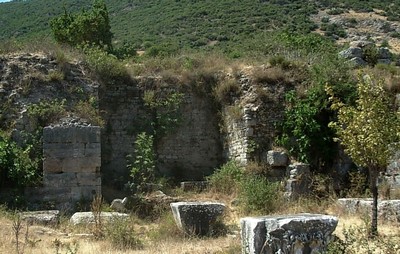 |
HOUSE OF VIRGIN MARY-(Meryemana in Turkish) Located on the top of the "Bulbul" mountain 9 km ahead of Ephesus, the shrine of Virgin Mary enjoys a marvelous atmosphere hidden in the green. It is the place where Mary may have spent her last days. Indeed, she may have come in the area together with Saint John, who spent several years in the area to spread Christianity. Mary preferred this remote place rather than living in crowded place. The house of Virgin Mary is a typical Roman architectural example, entirely made of stones. In the 4th century AD, a church, combining her house and grave, has been built. The original two-stored house, which consisted of an anteroom (where today candles are proposed), bedroom and praying room (Christian church area) and a room with fireplace (chapel for Muslims). A front kitchen fell into ruins and has been restored in 1940's. Today, only the central part and a room on the right of the altar are open to visitors. From there one can understand that this building looks more like a church than a house. Another interesting place is the "Water of Mary", a source to be found at the exit of the church area and where a rather salt water, with curative properties, can be drunk by all. |
|---|
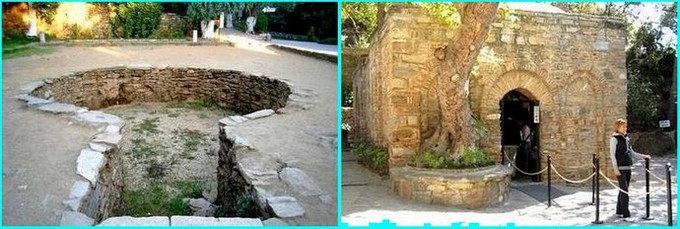 |
Paul VI was the first pope to visit this place in the 1960's. Later, in the 1980's, during his visit, Pope John-Paul II declared the Shrine of Virgin Mary has a pilgrimage place for Christians. It is also visited by Muslims who recognize Mary as the mother of one of their prophets. Every year, on August 15th a ceremony is organized to commemorate Mary's Assumption. The House of the Virgin is believed to be the last residence of the Virgin Mary, mother of Jesus. The peaceful site is sacred to both Christians and Muslims, and is visited by many tourists and pilgrims. |
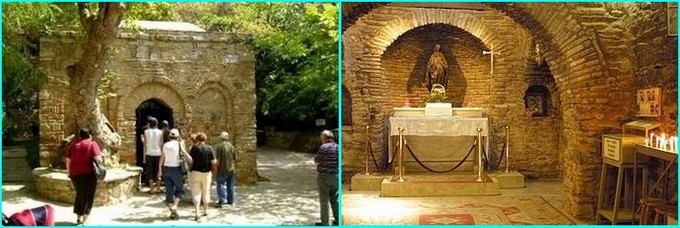 |
History According to predominant Christian tradition, Mary was brought to Ephesus by the Apostle John after the Resurrection of Christ and lived out her days there. This is based mainly on the traditional belief that John came to Ephesus (see St. John's Basilica) combined with the biblical statement that Jesus consigned her to John's care (John 19: 26 - 27). Archaeologists who have examined the building identified as the House of the Virgin believe most of the building dates from the 6th or 7th century. But its foundations are much older and may well date from the 1st century AD, the time of Mary. This site had long been a place of pilgrimage for local Orthodox Christians. |
 |
The modern history of the Virgin Mary's House is unusual. It was "discovered" in 1812 by a German nun, Sister Anne Catherine Emmerich, who never traveled away from her home. Sister Emmerich, an invalid confined to bed, awoke in a trance with the stigmata and visions that included the Virgin Mary and Apostle John traveling from Jerusalem to Ephesus. She described Mary's house in detail, which was recorded at her bedside by a writer named Brentano. Emmerich described a rectangular stone house, which John had built for Mary. It had a fireplace and an apse and a round back wall. The room next to the apse was Mary's bedroom, which had a spring running into it. The German nun went on to say that the Virgin Mary died at the age of 64 and was buried in a cave near her house. When her coffin was opened soon after, however, the coffin and burial shroud were empty. The house was then turned into a chapel. Years after Emmerich's visions, a French clergyman named Gouyet read Brentano's account and traveled to Ephesus to find the House of the Virgin. He found a house matching the nun's description and sent word to the bishops of Paris and Rome, but didn't receive much of a response. On June 27, 1891, two Lazarist preists and two Catholic officials set out to Ephesus to see the house. They found a small chapel in ruins with a damaged statue of the Virgin. |
 |
They returned to Izmir with their report, and more priests and specialists were sent out to the site. Since 1892 the House of the Virgin has been a Catholic pilgrimage site. It was restored by 1897 and a shelter for visitors was set up. The Meryemana was later visited by Popes Paul VI and John Paul II, who confirmed its appropriateness as a place of pilgrimage. On November 29, 2006, Pope Benedict XVI celebrated mass here. What to See The House of the Virgin is a sacred site for both Christians and Muslims (Muslims also believe in the virgin birth and honor Mary as the mother of the Prophet Jesus). The shrine is still in the care of the Lazarist Fathers, who celebrate Mass here every day. Two resident nuns also recite the Divine Office daily. The small, T-shaped stone building consists of a bedroom (on the right) and a kitchen (on the left). The interior is kept simple and austere, fitted only with an altar, images of Mary and candles. |
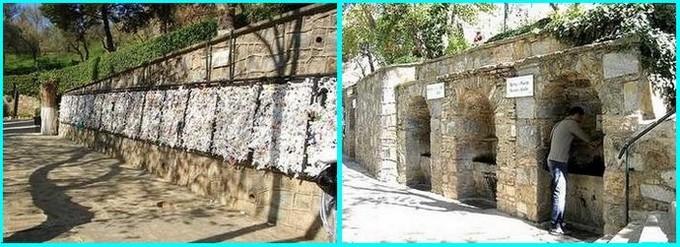 |
The spring that runs under the Virgin's House is believed to have healing properties, and many miracles have been reported. Inside the house are crutches and canes said to be left behind by those who were healed by the sacred spring. The site is wheelchair accessible and provides clean public restrooms. Festivals and Events : On August 15 (the Feast of the Assumption of Mary) each year, Catholic, Orthodox and Muslim clergy conduct a service together at the shrine, one of the rare occasions this happens anywhere. |
Christianity & St.John & Mary & Duble Churche in video 33.50- 41.20->
MARBLE ROAD It is the road starting from the great theatre to the Celsus Library, which is the portion of the sacred way that leads past Panayirdagi to the Temple of Artemis. The construction of the marble road dates to the 1st century A.D, and it was rebuilt in the 5th century. The western side of the road is enclosed by the agora wall, and on the wall is a higher platform, which was constructed during the reign of Nero. It was built over the wall, for pedestrians. On the marble road, there are some drawings believed to be an advertisement of the Brothel. This advertisement is known as the first advertisement in history. There is a footprint on the advertisement, one finger showing the library, and other showing the brothel. The known explanation of this sign is that the footprint shows that one should turn at that point; the woman's head symbolizes the women waiting in the Brothel and the heart shows that the women are eager for love. The busts and statues of the important people were erected along the road, and the letters from emperors were carved into the marble blocks to let people read. |
|---|
Marble Road in video 21.50- 22.12-> |
 |
HADRIANS GATE :( 113-118 AD) is located at the junction of the Curetes Street and the Marble Street. The gate house has three stories. On the first story there are three entrances. The one in the center is wider and spanned by an arch and the other two side entrances are capped by architraves. The second story was formed of four pillars and the third story of six pillars. A gable marks the top of the building... |
CELSUS LIBRARY This library is one of the most beautiful structures in Ephesus. It was built in 117 A.D. It was a monumental tomb for Gaius Julius Celsus Polemaeanus, the governor of the province of Asia; from his son Galius Julius Aquila. The grave of Celsus was beneath the ground floor, across the entrance and there was a statue of Athena over it. Because Athena was the goddess of the wisdom. The Library of Celsus is 21m wide and over 16m high with a 2.4m-deep portico. The mausoleum-library originally had three stories, with galleries in the upper two stories. |
|---|
 |
The scrolls of the manuscripts were kept in cupboards in niches on the walls. There were double walls behind the bookcases to prevent the them from the extremes of temperature and humidity. In total, 30 bookcases held about 12,000 scrolls. The reading room faced east in order to take advantage of the best light. It was the third richest library in ancient times after the Alexandra and Pergamum. |
 |
The facade of the library has two-stories, with Corinthian style columns on the ground floor and three entrances to the building. There is three windows openings in the upper story. They used an optical trick that the columns at the sides of the facade are shorter than those at the center, giving the illusion of the building being greater in size. |
|---|
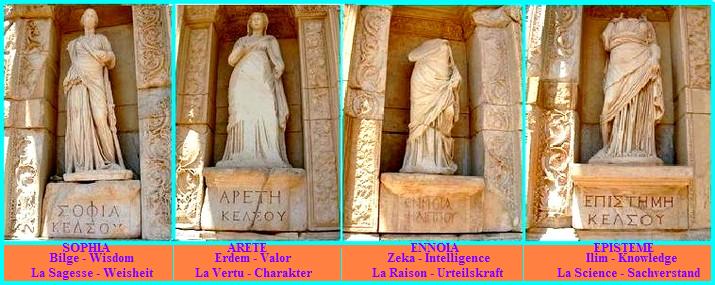 |
|---|
The statues in the niches of the columns today are the copies of the originals that were taken to Vienna-Ephesus-Museum in 1910. The statues symbolize wisdom (Sophia), valor (Arete), intelligence (Ennoia) and knowledge (Episteme). These are the virtues of Celsus.With a few centuries of its construction a fire destroyed the reading room and the library fell into disuse. |
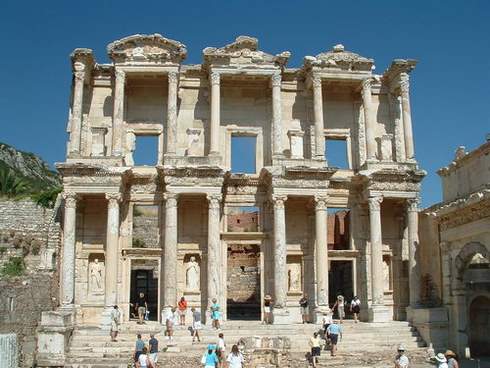 |
Around 400 AD, the courtyard below the exterior steps was converted into a pool. The facade collapsed in an earthquake in the 10th century. The Library of Celsus was raised from the rubble to its present splendid state by F. Hueber of the Austrian Archaeological Institute between 1970 and 1978. There was an auditorium,which was for lectures or presentations between the library and the Marble Road, was built during the reign of the Emperor Hadrian. |
|---|
 |
|---|
Celsus Library in video 18.10 - 22.12
 |
THE MEMMIUS MONUMENT is located to the north of Curettes Road across the Domitian Square. It is a four sided victory arch. It was a memorial which was dedicated to Memmius, son of Caius. It was constructed during the reign of Augustus in the 1st century A.D by Memmius, the grand son of dictator Sulla. One can see the figures of his father and grandfather on the blocks today. The structure has four facades, in the 4th century A.D, a square fountain was built on the northwest facade. Dictator Sulla was a hero for the Romans in Ephesus.When the taxes were too high in Ephesus they were fed up with the yoke of Rome.They needed a miracle and it was Mithridates of the Pontic Empire on the Black Sea Coast.His famous motto was Asia for Asiatic. He killed 80,000 Romans with his army.Three years after his revolt, the Roman army, under the command of Sulla, conquered Mithridates and brought security. According to an inscription, It was built to remind this conquer in 87 BC. by the Memmius family. Partical restoration has been carried out with surviving fragments. |
|---|
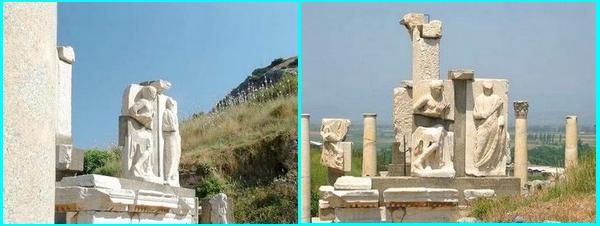 |
|---|
| During the 4th century A.D. a large fountain (hydreon) was built onto the north-west facade. This fountain with rectangular pool.dated 4th century B.C.Four statues of Roman emperors (like in Hadrien Temple)was rising on the pedestal in front of the pool ; Diokletien, Maximien, Constance Chlore and Galer (M.S. 293-305) |
 |
EPHESSUS MUSEUM Ephesus Archaeological Museum is located in Selcuk, which is 70km away from Izmir, where Ephesus ancient city is found. Selçuk-Ephesus Museum is the most important and the richest museum of Europe with the artifacts it owns and with only the local artifacts it exhibits. Ephesus Museum is a rich local museum with its very important findings for the Ephesus and Anatolian archeology the majority of which have been brought from the excavations in Ephesus, the Church of St. John, Belevi Mausoleum and the other historical sites in the vicinity. There are artifacts belonging to Mycenaean, Archaic, Hellenistic, Roman, Byzantian and Turkish periods. However, the majority of the artifacts belong to the Hellenistic, Roman and Byzantian periods. |
|---|
 |
Terrace Houses and the Hall Displaying the House Relics: The findings the majority of which belong to the Roman Age and which were found in the Terrace Houses which were excavated in the last 50 years, are exhibited in the first hall of the museum. On the left hand side are the plans and the excavation photographs of the houses and the artifacts related to medicine and cosmetic are on the first showcase. The house cult and the household utensils are on the second showcase. The most interesting of them is the glass tray. In the front is the Statue of Artemis the Hunter in the niche on the fresco wall brought from the corner (turkeyarena.com) of a house and next to it on the left hand side is the Head and the Fresco of Socrates (3rd century). The bust of the Emperor Marcus Aurelius and the statuettes of the Fertility God Priapos and Bes are on the right hand side of the hall. Three of the most important findings of the museum are exhibited in the middle of the hall. One of them is Eros with Dolphin dated 2nd century AD. Another one is the statue of the Egyptian Priest. The last one is the Roman period copy of the head of the Eros statue of the famous Lysippos. |
 |
The Hall of Fountain Relics: The relics uncovered during the excavations in the fountains of Pollio, Trajan and Laecanus in Ephesus are displayed in this hall. The bust of God Zeus and the statue of Aphrodite are located on the left hand side of the entrance. In the middle of the hall is the statue of the Resting Warrior. The statue of Odysseus Polyphemos adorning the Pollio Fountain are on the left. The statue in front of them belongs to the Trajan Fountain. The former of them is Dionysos who leans on a trunk of a tree. Lying Satyr, Aphrodite who carries an oyster shell on her paunch and Androklos and his dog are the other statues. There is a series of busts on the right hand side of the hall. Next to them are the statues found in the Laecanus Bassus Fountain. |
 |
The Hall of Currently-Found Relics: Some of them are displayed here for one or two years. There are Byzantian findings generally belonging to the Christianity Period are on the showcase which is located on the right hand side of the hall. Until the Roman Period the bee which is the symbol of Ephesus was on the front side and the holy deer of Artemis on the back side of the Ephesus coins. During the Roman Period, the pictures of the emperor and his relatives or their symbols were on the front side. The masks hung on the left wall were found in the theater. The masks used in the theater were made either of leather of wood. These masks which were made of stone were used for decorative purposes. The making of an Ephesus oil lamp is shown on the same wall by drawings. The Masked Eros, amphoras, the figure of Eros, the statue of Aphrodite, various busts (turkeyarena.com) and the bust of the comedian writer Menander are important artifacts of the hall. The only permanent artifact in the hall is the ivory frieze found in the Terrace Houses. The war of Trajan with the eastern barbarians and his preparations for this war are depicted in the frieze in 3 sections. |
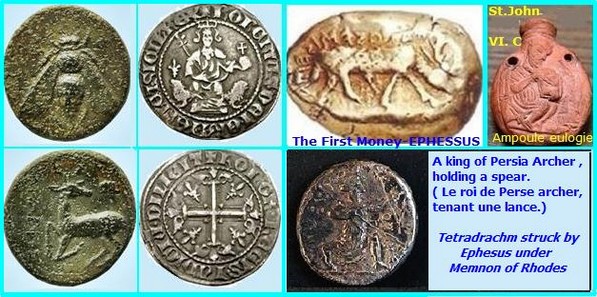 |
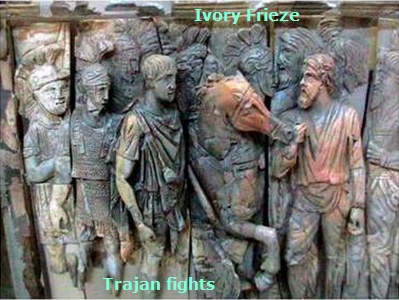 |
The Ivory Frieze from an upper story of one of the Slope Houses, which depicts the emperor Trajan and his Roman soldiers battling barbarians. Other everyday items include a collection of medical and cosmetic tools, used by the important medical school in Roman Ephesus, and a wall of portraits of Ephesian physicians. |
|---|
The Garden: A beautiful garden which is in accordance with the local architecture was constructed in the museum. There are sarcophagi, graves, altars and inscriptions in the right side of the garden including the pediment from the Temple of Augustus (Isis Temple). It has been reassembled using the original statues, which had been used in the Fountain of Polio after the temple was destroyed. The decoration of the sarcophagus belonging to the 2nd century AD is especially very interesting. Figures of Moses surround the sarcophagus. According to the inscription on its lid, it was reused during the Byzantian time. Also out here is the Ephesus Monument, inscribed with tax regulations, which was issued by Emperor Nero in 62 AD. The graves and altars are exhibited on the western wall of the garden. The sundial in the middle is composed of a timescale which is in the shape of a half circle. The Hall of Grave Relics: The grave relics are displayed in this hall which has an entrance also from the garden. The burying customs in Anatolia are shown by drawings on the right wall. The small belongings uncovered from a Mycenaean grave which is located in front of the Church of St. John are on the first showcase on the left side. These belongings are dated to the 14-13th centuries BC and they are important for they prove that the history of Ephesus began before Androklos. On the other showcase, the glass belongings unearthed from the graves in Ephesus and in the vicinity are exhibited. The stelles are placed at the end of the hall where there are many sarcophagi and ostatechs. |
|---|
 |
Artemis Hall: The statues of Artemis and the findings related to Artemis are exhibited here. The two beautiful Artemis statues are presented to the visitors in accordance with their fame. They were found by coincidence in Prythaneion (See Artemis of Ephessus in Prytaneum) and dated to the 1st century AD. The statue on the left is called Great Artemis and the statue in front of it is called Beautiful Artemis. The findings uncovered in the Temple of Artemis are displayed on the showcases. One of the horses of the chariot (turkeyarena.com) which had four horses and which adorned the altar of the Temple of Artemis is also in this hall. The Hall of the Cults and Portraits of the Emperor: Generally, here are the busts of the emperor and his families. The most striking point is that a cross was drawn on the foreheads of some busts. The statue on the right side of the entrance near the Artemis hall belongs to consul Stephanos. The original friezes of the same temple can be seen on the two sides of the picture of the Hadrian Temple on the left (See Temple Hadrien). |
 |
The altar in the middle is one of the 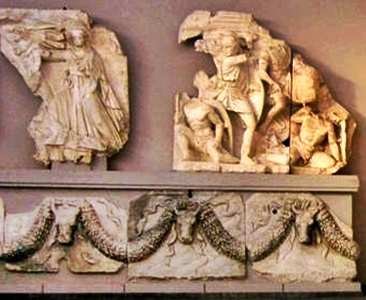 |
parts of the U-shaped altar of the Domitian Temple. Three sides of it have friezes. The found parts of the huge statue of the emperor Domitian (See Domitian Temple) are located in the exit of the hall. Also, the statue of Augustus and his wife Livia and some parts of the Parthian monument adorn this hall. Location: On the edge of the park opposite the Tourist Information Office. Phone: 0232-892-6010 /0 232-892-6011/ Hours: Tues-Sun 8:30am-6pm. |
|---|
Efes Museum in video 23.05- 24.37->
 |
|---|
Temple of Isis The temple was dedicated to Isis, surrounded by 10 columns on the long side and 6 on the short side. It was collapsed during the reign of Augustus and was not re-built again, as Emperor Augustus' dislike of anything Egyptian because of his hostility towards Anthony and Cleopatra. Some of the parts of this building was used for the construction of The Pollio Fountain. On the facade of the Temple, there were group of statues describing the legend of Odysseus and Polyphemos (See in The Pollio Fountain) which are now displayed in the Ephesus Museum. |
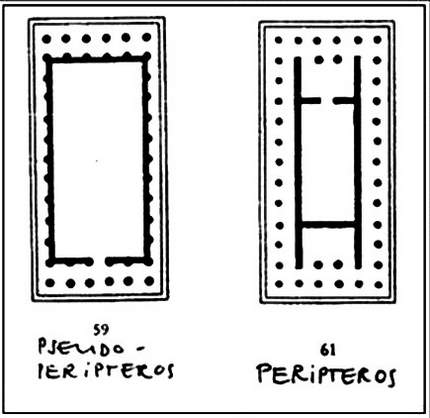 |
Ephesus throughout its history always had a large Egyptian population and Isis was a very important Egyptian goddess. She is the wife and sister of Osiris and the mother of Horus. There was a temple of Isis rectangular in shape and in the center of the State Agora. The temple was built during the Hellenistic period when Ephesus had close relations with Alexandria. Her name literally means "Queen of the throne", which was portrayed by the emblem worn on her head, that of a throne. She is known as being the goddess of magic and healing. Ancient Egyptians believed that the Nile flooded every year because of her tears of sorrow for her dead husband, Osiris. He was killed by her other evil brother, Set, god of chaos and destruction. Her origins are uncertain but are believed to have come from the Nile Delta; however, unlike other Egyptian deities, she did not have a centralized cult at any point throughout her worship. First mentions of Isis date back to the Fifth dynasty of Egypt which is when the first literary inscriptions are found, but her cult became prominent late in Egyptian history, when it began to absorb the cults of many other goddesses. It eventually spread outside Egypt throughout the Middle East and the Roman Empire, with temples dedicated to her built as far away as the British Isles. Worshipping of her remained in Christian Europe as late as the 6th century. Isis gave the hope of eternal life or resurrection. In Anatolian religions this idea gained popularity because there had been no belief in an after life before her. Today the name Isis is still a beloved name among modern Coptic Egyptians, and in Europe the name Isadora is very common. |
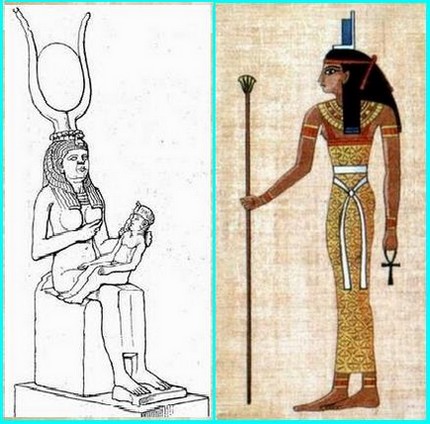 |
FOUNTAIN OF TRAJAN Built in around 104 C.E, it is one of the finest monuments in Ephesus. It was constructed for the honor of Emperor Trajan, and the statue of Trajan stood in the central niche on the facade overlooking the pool. The pool of the fountain was 20x10 meters, surrounded by columns and statues. |
|---|
 |
On the front facade there was a life-size statue of Trajan of which only the right foot and a portion of the torso has survived. A sculpture depicting Dionysus, two reclining satyrs ,a statue of Aphrodite and the family of the Emperor discovered here are now exhibited in the local museum. It is a two-storey structure 12 m in height surrounding the pool in front on three sides. It has undergone partial repair ,the restoration has not been finished yet. |
|---|
 |
|---|
BATHS These baths were built in the first century CE, yet expanded in the fourth century. Baths were a very important part of Roman society. Here are typical components of Roman baths: Apodyterium = changing room,Palestra = Greek style wrestling room,Frigidarium = cold bath ,Tepidarium = a warm bath,Caldarium = the hot tub The Roman men would generally utilize the baths during the late afternoon, while conducting business and socializing with friends and patrons/clients. One would first enter the Apodyterium where they would change out of their clothes and prepare for the baths. Some baths were equipped with a Palestra for exercise and training. Some baths had separate bathing areas so that the women could utilize the facilities as well, but for those baths that did not have separate bathing areas, the women probably bathed between nine and three o'clock. The Baths of Scholastica It was built in the First Century and restored in the Fourth Century by a rich Christian lady called Scholastica. On the left of the eastern entrance, you can see her statue without head. |
|---|
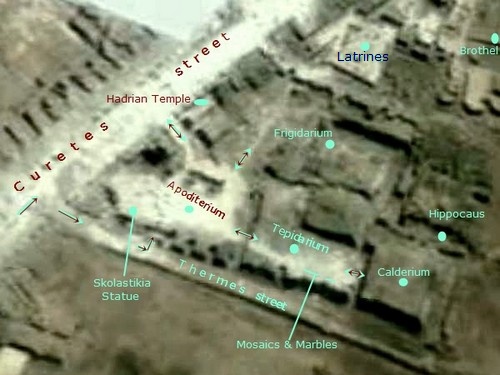 |
The original structure was thought to have been three-storied but by the time the upper two stories collapsed. The baths have two entrances, one from the Curetes Street, which is the main entrance, and the other from the side street. When you enter you see first the dressing room (apodyterium) with ten cabins,then cold room (frigidarium) with its pool,and then the warm room (tepidarium) to relax, and finally the hot room (caldarium) with its developed heating system.The second floor was used for masseage and scrubbe as a therapy. It was used not only to bathe but also to socialize and discuss the topics of the day.The importance of discussing in the bath is well-known and effective developing of Roman philosophy. The custom of Roman baths was continued during the Byzantine era and with the arriving of the Turks reached its heyday.During the times of the Ottomans, it won another dimension.It is recommend you to visit one of the traditional Turkish Bath to feel this culture. |
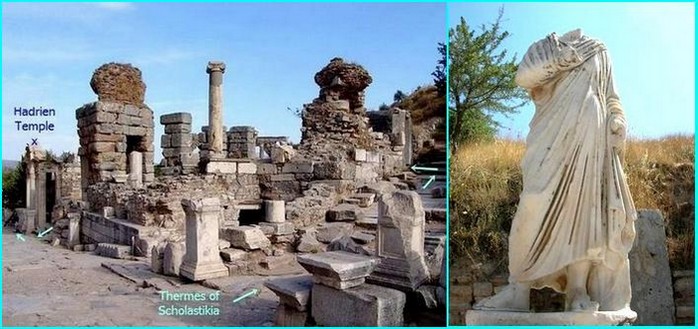 |
| THE HELLENISTIC FOUNTAIN The Hellenistic fountain located just across the Theater facing to the west was built in traditional Ionian style. It is estimated to be built in the 3rd century B.C. This elegant Hellenistic fountain with two columns on the front is a very unique example of the careful and stylish Ionian workmanship. The column heads and pedestals are of great interest to spectators. |
|---|
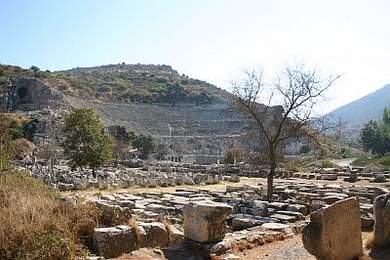 |
Theatre Gymnasium The building is situated at the eastern end of the Arcadiane Street. It is one of the Ephesian bath-gymnasium building. The form of its palaestra (place of exercise) with a tribune shows that it had a specific function. The bathing section has been partially excavated and so inaccessible. There were lobbies, warm bathing pools, frigidarium, recreation rooms and halls for training. |
Mosaics and PORTICO OF ALYTARCH Sections of The Terrace Houses islands overlooking the Curates Street were shaped in stoa. Behind the stoa contains one row shops. All of the houses doors are directly opened to the street. Geometric-patterned mosaic pavement in front of shops is dated to the beginning of the 5th century B.C. Also the stairs to be seen in the two shops indicates the existence of a second floor out the ground floor. |
|---|
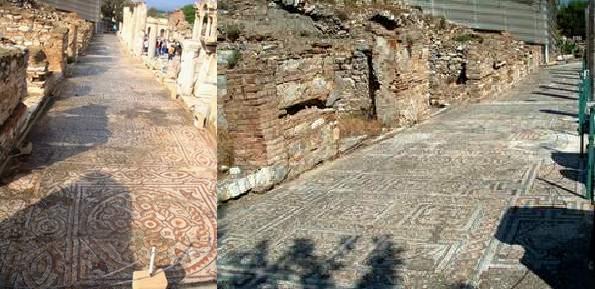 |
Beginning in Hellenistic times there was a growing trend for new religious groups to move into urban environment alongside the cults.These new groups came from the Eastern Mediterranean and Middle East in the wake of Alexanders conquests and the subsequent centuries of Hellenistic rule.By the firs century BCE these regions came under Romen rule, but by then the pathways of migration and cultural interaction had been well worn.Many people were drawn by trade and migration to the large cities.With them they carried their culturel heritage and their religious traditions.Their collegial halls thus served both as commercial agencies and as religious and social centers. Once out of the realm of the official cults associated with the state or the city, there was much more variety in religious activities. Houses might be turned into cult centres or collegial halls. A wealthy homeowner might also install his/her own private chapel in honour of a favourite deity or as part of a small religious confraternity. For example at Ephessus, a wealthy city official ( alytarch ) of the early second century CE, named C.Flavius Furius Aptus, owned a palatial house ( Hanghous 2 ) along the Embolos ( or Processional Way Curetes Street ). Of a peristyle court reached from a mosaic portico along the street, he installed a small apsidal shrine to Dionyssus next to an opulent dinig hall, It seems that these rooms were meant for formal entertaining of small elite groups (Wiplinger and Wlach 1995: 103 4 ). |
CHURCH OF MARY The Double Churches This Roman building is dated to the 2nd century A.D as the Hall of the Muses. It was used as an education and cultural center. After the christianity became the official religion of Rome, they converted this building into a basilica. It was the first church dedicated to the Virgin Mary. It is also known as the Double Church, because it is thought one aisle was dedicated to the Virgin and the other to St. John, and the Council Church because the Council of Ephesus is believed to have been held here. It was 260 m. in length, and was built with columns in the form of a fine basilica with baptistry. After it was partly destroyed, the western part formed a domed basilica, and when this too was ruined, the eastern part of the old basilica was turned into a church. So it is also called as the Double Churches. The baptistry of this church is the best preserved in Asia Minor. The Third Ecumenical Council was held in Ephesus, Asia Minor, in 431 under Emperor Theodosius II, grandson of Theodosius the Great. It is also known as the Council of Ephesus. Approximately 200 bishops attended. Here, the divine character of Christ and the Virgin Mary was discussed. Nestorius (380 - 451), the founder of the school of Antioch and the Patriarchate of Istanbul, rejected the divine nature of Christ and regarding Mary not as the mother of God but as the mother of a human being. The Alexandrian school, on the other hand, claimed the more mystical, more traditional view that Mary was the mother of God and in the end Nestorius was sent exile. So at this counsil it was decided that Christ had a double nature as God and man, and the Virgin Mary was theotokos, god-bearer. |
|---|
The Church of the Virgin was a classic rectangular basilica enclosed by rows of columns 260 meters long from the Roman stoa, with lateral walls added between them around 500 AD. Entrance was through a large atrium, paved with marble slabs from other buildings in the city, and a narthex, paved with geometric mosaics. The walls were decorated with crosses and metal rosettes. |
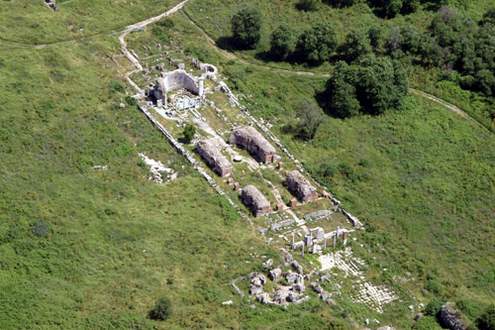 |
|---|
The well-preserved baptismal pool can still be seen on the north side of the church, and it is the best preserved of any in Anatolia. In addition, many of the walls and pillars of the church remain standing, along with the great apse, several capitals, and blocks inscribed with a cross. |
|---|
 |
History A great ecumenical council was held in Ephesus in 431, concerning whether the Virgin Mary might properly be called Theotokos, or bearer of God. The term had become popular in devotion and worship but was controversial. Many church leaders held that it was an appropriate title, reasoning that since Christ was both truly man and truly God, one could say Mary gave birth to God. Nestorius, Bishop of Constantinople, and his party believed the term "Theotokos" threatened the humanity of Christ and denigrated the greatness of God, and suggested Mary be called "Christotokos," bearer of Christ, instead. The council decided in favor of the Theotokos title, which has been used for Mary ever since. Nestorius was harrassed by mobs in Ephesus throughout the council, and exiled to Antioch afterwards. The Acts of the Council of Ephesus, which record the events and discussions of the months-long council, state that the sessions took place in "the church named after Mary." Until recently, it was thought that this Church of Mary was built under the reign of Constantine the Great ( 32430 ), based mainly on its architectural style. The most recent excavations indicate that the Church of Mary was built into the south stoa (portico) of the great Olympieion (Temple to Hadrian Olympios), whose foundations can be still be seen to the north of the church. The Olympieion was a large temple precinct built from about 100 to 130 AD on a filled-in swampy area next to the harbor. The great imperial temple dedicated to Emperor Hadrian (who identified himself with the Olympian Zeus) earned Ephesus its second neokorate, the honorary title of neokoros or "temple-warden" that brought various privileges. The south stoa that would later contain the Church of Mary was built after the Olympieion, around 200 AD. It was a monumental entrance to the sanctuary, but also an important building in itself. It has been variously identified as a corn exchange, public meeting house, or museion (science teaching center), but Karweise believes it was probably another imperial temple, dedicated to the joint emperors Caracalla and Geta. Ephesus earned its third neokorate from this temple in 211. Whatever its original use, this basilica-like building south of the Olympieion was abondoned in the 3rd century, when the city was in decline because of a great plague and the attacks of the Goths in 258-62. The Church of Mary was later built in the ruins of this Roman building. |
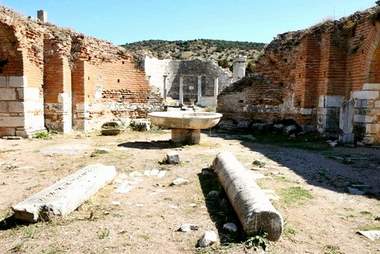 |
In the 1990s, Stefan Karweise and his archaeological team excavated the Church of Mary with surprising results. He reports: In a trench outside the church wall, secure evidence was found in the foundation ditch proving that the church was not built as early as the period of Constantine nor even in 431, but several decades later. Archaeological evidence from sherds and coins has proven beyond doubt that the lateral walls, consisting of huge limestone blocks which might have come from the foundations of the Olympeion, were not erected before about 500. Since these walls closed the open sides of the Roman stoa, they belong to the time when the church was founded. The Constantinian date must be rejected and instead a date in the reign of Anastasius I [491-530] must be employed. Similarly, it is clear that the block walls did not replace older church walls, since there is no evidence of this. The dates of the baptistery and narthexes have not yet been verified. Whenever it was built, the Church of Mary served as the cathedral of Ephesus, with the bishop living in an adjacent palace, throughout Late Antiquity. One alteration during this time is attested by an inscription: one Bishop John had a portal cut through from the atrium to the narthex. This may be the bishop who was installed at the Council of Chalcedon in 451. In the 530s, Hypatius was bishop of Ephesus. An important figure beyond Ephesus, Hypatius was a leading theologian and writer who fought against the heresy of monophysitism at synods in Constantinople and was sent by Emperor Justinian on a diplomatic mission to the Ostrogothic government in Rome. At home in Ephesus, Hypatius presided over the early stages of construction of the Basilica of St. John, a massive project which was financed by Justianian perhaps in part because of the influence of Hypatius. In his own cathedral, the Church of Mary, Hypatius commissioned a long inscription carved on revetment plaques in the narthex. The decree deals with the burial of the poor, an important charity provided by the church. It recalled the example of the Lord, who was buried in a tomb donated by Joseph of Arimathea, and ordains that no church official should take money for burial services. The inscription shows the continued importance of the Church of Mary, which is called "the most holy church." After the Arab raids of 654 the bishop moved to the Basilica of S. John and remained there for two centuries until it came under attack in 867. The Paulicians, a militant Armenian sect, turned the Basilica of St. John into a stable and the bishop moved back to the Church of Mary, which was repaired and partially rebuilt for that purpose. The later history of the Church of Mary is less clear, as the city of Ephesus was in sharp decline. But sealed graves have been discovered in and outside of the church that date all the way to the late medieval period, indicating the church was still in use by local Christians until at least the 14th century. Today, the church is mostly in ruins. |
Temple of Hadrian This Corinthian temple is one of the best preserved and most beautiful structures on Curetes Street. It was built before 118-138 A.D. and was dedicated to the Emperor Hadrian, who came to visit the city from Athens in 128 A.D. but underwent repairs in the 4th and has recently been re-erected from the surviving architectural fragments. The reliefs in the upper sections are casts, the originals being now exhibited in the Selcuk Archaeological Museum. The temple is a veritable miracle, a peerless specimen of Roman architecture. It measures 7.20 by 5 meters. The facade of the temple has four Corinthian columns supporting a curved arch, in the middle of which contains a relief of Tyche, goddess of victory. The side columns are square. The pedestal with inscriptions in front of the temple, are the bases for the statues of the emperors between 293-305 CE, Diocletian, Maximian, Constantius I, and Galerius; the originals of the statues have not been found yet. |
|---|
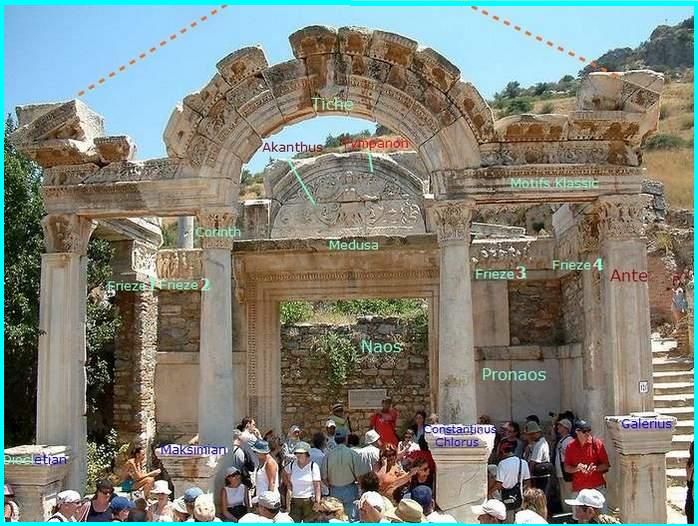  |
Inside the temple above the door, a figure of Medusa stands with ornaments of acanthus leaves. On both sides there are friezes depicting the story of the foundation of Ephesus - Androklos shooting a boar, Dionysus in ceremonial procession and the Amazons. |
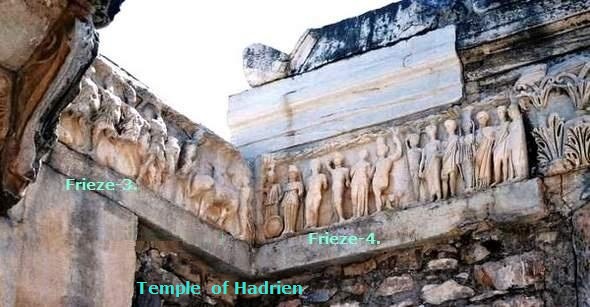 |
The fourth frieze portrays (1) the goddess Athena; (2) Selene/ goddess of the moon; 3-a male figure, (4)Apollo; (5) a female figure, (6) Androkles, (7)Herakles,(8) Theodosius , (9)Father of Theodosius, (10)Artemis, (11) the wife (Aelia Flaccilla) and(12) the son (Emperor Arcadius) of Theodosius and (13)Athena. The friezes that are seen today are copies, and the originals are displayed in Ephesus Museum. The Temple of Hadrian is one of the main attractions at Ephesus, with a beautiful arch on the front facade and interesting reliefs of Medusa and other scenes inside. |
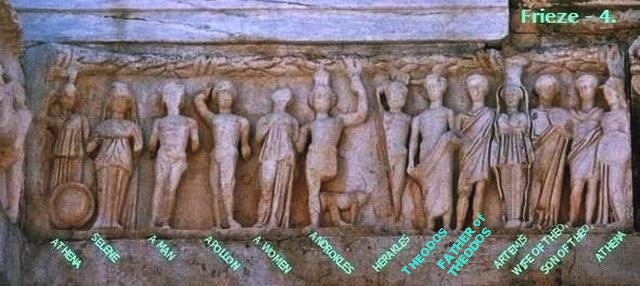 |
History An inscription tells us the temple was erected around 118 AD by one Publius Quintilius (who is otherwise unknown). The name "Temple of Hadrian" is not really accurate: it is more a monument than a temple, and was dedicated not only to Hadrian but also Artemis and the people of Ephesus. The temple was partially destroyed in the 4th century, and it was during the course of restorations that the four decorative reliefs were added to the lintels of the interior of the porch. The small, simple structure consists of just a pronaos (porch) and small cella (main hall). The porch is supported by two pillars and two columns of the Corinthian order. The architrave contains the dedicatory inscription from Publius Quintilius to Hadrian, Artemis and the people of Ephesus, and includes a bust of the goddess Tyche, protectress of the city. The pediment and decorative frieze of the pronaos have disappeared. In the arched tympanum over the main portal is a carving of a half-nude woman surrounded by acanthus leaves; some identify the figure as Medusa, symbolically keeping evil spirits away. |
 |
The cult statue of Hadrian once stood on a low podium at the end wall of the cella, but has been lost. The bases in front of the porch facade are inscribed with the names of Galerius, Maximianus, Diocletianus, and Constantius Chlorus, indicating that the bases originally supported statues of these emperors. The interior of the monument is decorated with panels of reliefs along the top. The ones in place today are plaster replicas of originals protected in the Ephesus Museum. The first three panels from the left depict the mythological foundation of Ephesus, and show representations of Androklos chasing a boar (part of the founding myth of Ephesus), the battle between Hercules and Theseus, and gods with Amazons. Most of these were taken from a 3rd-century building and placed here in the 4th-century reconstruction. Emperor Theodosius and the Pagan Gods? The fourth panel was created new at the time of the 4th century reconstruction, and is very interesting for the religious history of Ephesus. It shows Emperor Theodosius (who outlawed paganism) and his family surrounded by Athena, Apollo, Androklos, Heracles, Artemis of Ephesus, and several other historical and mythological figures. In 381, the Christian Emperor Theodosius outlawed pagan cults throughout the empire. Not long after this, a curious relief was added to the so-called Temple of Hadrian in Ephesus. It shows the great anti-pagan campaigner Theodosius and his family accompanied by gods including Artemis of Ephesus, Athena and Selene! In light of the themes of the other reliefs on the same structure, which include such founding legends as the wild boar hunt of Androklos, it may be the relief is not primarily religious in nature but rather "indicates that he [Theodosius] was regarded as the new founder of Ephesus." The imagery of the gods may thus be intended as symbols of the city and of traditional legends rather than a religious statement. Still, the combination of such an anti-pagan Christian figure with the old gods certainly demonstrates the lack of violent opposition towards the latter that will become prominent in the fifth century. And indeed, paganism was by no means a thing of the past in Ephesus by the end of the fourth century. |
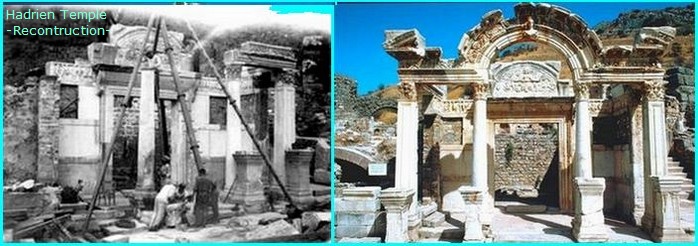 |
Hadrian Temple in video 26.42- 27.09->
Athena : is the goddess of civilization, wisdom, strength, strategy, craft, justice and skill in mythology. Minerva, Athena's Roman incarnation, embodies similar attributes. Athena is also a shrewd companion of heroes and the goddess of heroic endeavour.Selene : was an archaic lunar deity and the daughter of the Titans Hyperion and Theia. In Roman mythology, the moon goddess is called Luna, Latin for "moon".Like most moon deities, Selene plays a fairly large role in her pantheon, which preceded the Olympic pantheon. However, Selene was eventually largely supplanted by Artemis, and Luna by Diana. |
|---|
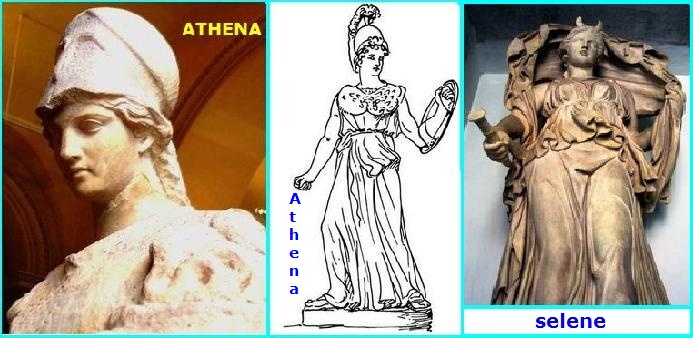 |
PRYTANEION Known as a place of worship dedicated to Artemis Boulaea, the Prytaneion was built during the reign of the Emperor Augustus, (27 BC - 14 AD). underwent repairs in the 3rd century B.C, during the reign of Lysimachos and was destroyed at the end of the 4th.History In Hellenistic and Roman times, Hestia (Vesta), the sister of Zeus and Hera, was honored not just in temples but in every home, as she was goddess of the hearth (the center of domestic worship).Hestia's sacred fire in the Prytaneion was never allowed to go out, and it was the job of the priests there to tend it. In addition to its religious purpose, the Prytaneion was an important civic building and it was where official guests to Ephesus were received by the religious and civic leaders of the city.The Prytaneion was a large temple-like hall fronted by a Doric courtyard surrounded on three sides by a colonnade. The courtyard was paved with a mosaic depicting the shields of Amazons against a decorative background. |
|---|
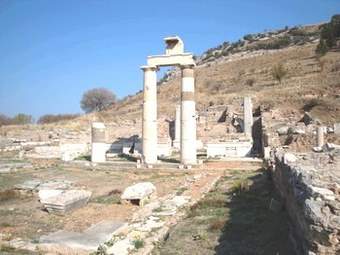 |
Two of the pillars that have been re-erected bear inscriptions with the names of the Curetes. Scholastica took columns and other materials from the Prytaneion for the construction of her baths on Curetes Street in the 4th century. The Prytaneion, where religious ceremonies , official receptions and banquets were held, was to be found an urban sanctuary consisting of a square chamber paved with black and white marble containing an altar in a niche in front of which stood a figurine of the goddess Hestia, while the courtyard contained a statue of Athena. Here, too, burned the sacred (eternal) flame symbolising the life of the city. The four-cornered pit in which the sacred fire is burned is a relic from the reign of Lysimachos. |
|---|
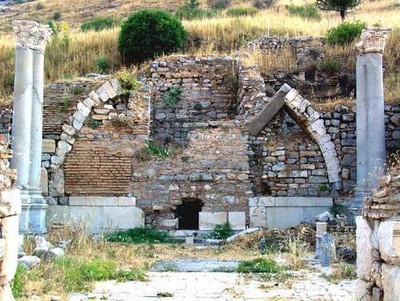 |
The large building consisted of a courtyard surrounded by porticos containing rooms and chambers, the colonnaded courtyard opening into a rectangular chamber with a roof supported by four Corinthian columns, three of which have survived.Towards the back, there was a large area with wooden roof, the base of an altar is still recognizable today. The double columns on the corners of the hall held up the wooden roof.The building also had a secular function. The city administrators, foreign guests and local philanthropists would gather here to dine together. |
|---|
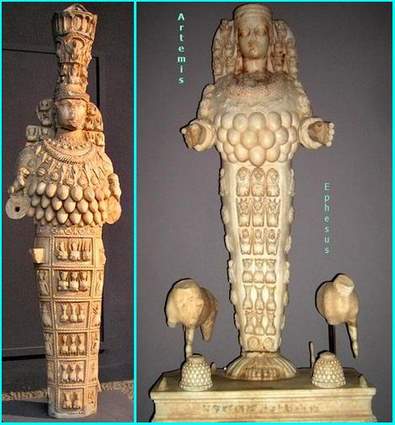 |
Two statues of the Ephesian Artemis were discovered in the Prytaneion and are now displayed in the Ephesus Museum. The larger statue, dating from the 1st century AD, was in the hall. The other, dating from about 50 years later, had been carefully buried in a small room in the sanctuary... Artemis is known as the goddess of the night, the huntress, the goddess of fruitfulness, the goddess of childbirth, Lady of the Beasts, the woodland goddess, the bull goddess. |
|---|
State Agora & Basilika & Pritaneum in video 19.00- 21.17->
BROTHEL A peristyle house on the corner of Curetes Street and the Marble Road is known as the brothel, because in the excavations, a statue of Priapus with an oversize phallus was found in the house. The statue is now presented in Ephesus Museum. The construction of the building dates to the Trajan (98-117 A.D.). It has two entrances, one from the Marble Road and one from the Curetes Street. It has a hall on the first floor, and on the second floor there are number of small rooms. On the west side of the house there is a reception area with colored mosaics on the floor, symbolizing the four season. The personified figures of Winter (with head covered) and Autumn (with a garland of flowers) are still well preserved. The chamber next to it is the bath of the house with an elliptical pool. On the floor of the pool, there is a mosaic describing three women eating and drinking, a waitress standing, a mouse and a cat nibbling crumbs. The ithyphallic figurine of Priapus or Bes, now in the Ephesus Museum, was found in a well on the side of the brothel near Curetes Street. The well is still in use. Of Egyptian origin, Bes was not the god of the brothel, but the protector of everything associated with motherhood and childbearing. 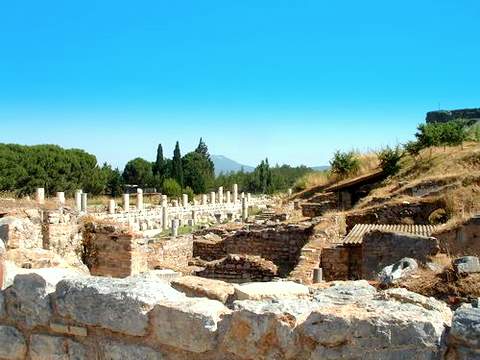 |
|---|
ARTEMISIUM The temple of Artemis is known as one of the Seven Wonders of the ancient world. It has been built in the areas of Ephesus on a flat area which has over the centuries turned into a swamp. Today one can only see the ruins of the foundations of this marvelous construction of the Hellenistic Age, entirely made of marble and full of sculptured columns' capitals and shafts. The most beautiful remaining of this temple are today exhibited in the London British Museum. The oldest remaining found date back till the 6th century BC. It was surrounded by 36 huge columns, later enlarged upon the orders of the Lydia King, Kreisos, during the 6th century BC. Most of the exhibits in the London British Museum belong to this period. The new Artemis has been rebuilt in the 2nd century BC. Located on top of the previous one, it had tremendous dimensions: 127 columns of each 17, 5 meters high. Unfortunately this one has also been destroyed by fire, reconstructed and again demolished by earthquakes, rebuilt and at last looted by Goths one year later. The statue of many-breasted Artemis was the symbol of the temple but also of abundance, hunting and wild life. The genuine statue of Artemis, removed during the fire, is today exhibited in the Selcuk Museum. Many copies of this statue found during the latest excavations date back from the Roman period. Mythological Info Artemis was also called Cynthia, from her birth place, Mount Cynthus in Delos. She was Apollo's twin sister, daughter of Zeus and Leto. She was one of the three maiden goddesses of Olympus: the pure maiden Vesta, gray-eyed Athena who cares but for war and the arts of the craftsmen, and Artemis, lover of woods and the wild chase over the mountain. She was the Lady of Wild Things, Huntsman-in-chief to the gods, an odd office for a woman. As a huntress her favorite animal was the stag, because its swiftness gave the best opportunity for her method of capture, which was by her silver bow and arrows and speed of foot. As Phoebus was the Sun, she was the Moon called Phoebe and Selene (Luna) representing the evening and night, carrying a torch, and clad in long heavy robes, with a veil covering the back of her head. Neither name originally belonged to her. Phoebe was a Titan, one of the older gods. So too was Selene, a moon-goddess, indeed, but not connected with Apollo. She was the sister of Helios, the sun-god with whom Apollo was confused. She was worshipped in Athens, Corinth, and Thebes as goddess of strict upbringing, of good fame, of upright mind, and of sensibility in the affairs of ordinary life. She chased and fired her arrows at all wild and unchecked creatures and actions. In the later poets, Artemis is identified with Hecate. She is "the goddess with three forms", Selene in the sky, Artemis on earth, Hecate in the lower world and in the world above when it is wrapped in darkness. Hecate was the Goddess of the dark of the Moon, the black nights when the moon is hidden. She was associated with deeds of darkness, the Goddess of the Crossways, which were held to be ghostly places of evil magic. |
|---|
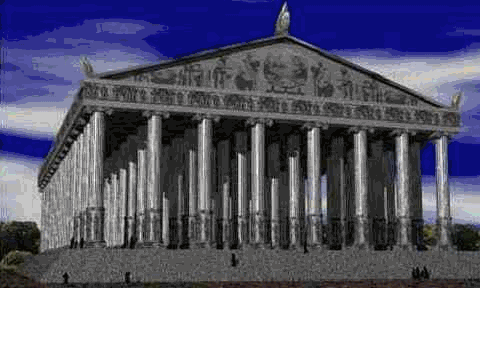 |
The Ephesian Artemis Artemis was the Greek goddess, the virginal huntress and twin of Apollo, who replaced the Titan Selene as Goddess of the Moon. At Ephesus a goddess whom the Greeks associated with Artemis was passionately venerated in an archaic icon. The original was carved of wood, with many breast-like protuberances apparently emphasizing fertility over the virginity traditionally associated with the Greek Artemis. Like Near Eastern and Egyptian deities (and unlike Greek ones), her body and legs are enclosed within a tapering pillar-like term, from which her feet protrude. On the coins minted at Ephesus, the many-breasted Goddess wears a mural crown (like a city's walls). She rests either arm on a staff formed of entwined serpents or of a stack of ouroboroi the eternal serpent with its tail in its mouth. Like Cybele, the goddess at Ephesus was served by hierodules called megabyzae, and by maidens (korai). A votive inscription dating from about the 3rd century BC associates Ephesian Artemis with Crete: "To the Healer of diseases, to Apollo, Giver of Light to mortals, Eutyches has set up in votive offering (a statue of) the Cretan Lady of Ephesus, the Light-Bearer." For a more in-depth look at Artemis of Ephesus and the role she played in Ephesian life and religion, please see our special article on Artemis of Ephesus. History The ancient temple, built around 650 BC to the cult of Artemis, was constructed on a site already sacred to the Anatolian Mother Goddess, Cybele. The temple was financed by the wealthy king of Lydia and marshy ground was selected for the building site as a precaution against future earthquakes. The temple soon attracted merchants, kings, and sightseers, many of donated jewelery and other treasures to Artemis and her temple. Its splendor also attracted many worshippers and pilgrims, strenghtening the cult ofArtemis. |
 |
On July 21, 356 BC, the night Alexander the Great was born, legend has it that a psychopathic arsonist intent on immortality set fire to the temple. Plutarch remarked that Artemis was too preoccupied with Alexander's delivery to save her burning temple. The arsonist, named Herostratus, was motivated by fame at any cost, thus the term "herostratic fame." The Ephesians, outraged, instructed that Herostratus' name never be recorded and that anyone who spoke of him should be put to death, but Strabo later noted the name. Twenty-two years later, during his sweep through Asia Minor, Alexander the Great offered to reconstruct the temple. In the famous refusal recorded by Strabo, the Ephesians said it would not be right for one god to build a temple to another god. The Temple of Artemis was eventually rebuilt remaining true to the original except for a raised platform, a feature of classical architecture adopted in the construction of later temples. By 263 AD, the temple had been plundered by Nero and destroyed by the Goths. The temple was again reconstructed in the 4th century, but by the end of that century the temple had been abandoned and was being used as a marble quarry for new buildings, including churches. The site of the temple was rediscovered in 1869 on an expedition sponsored by the British Museum, and several artifacts and sculptures from the reconstructed temple can be seen in the museum today. |
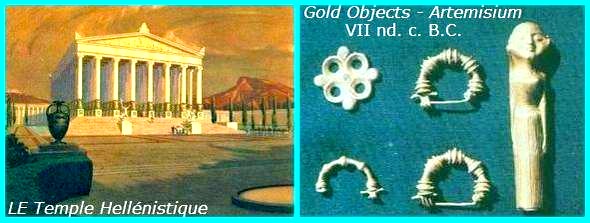 |
| What to See Rising out of the marsh, a lone surviving column suggests the immensity of the Wonder of the World, four times as large as the Parthenon and the first monumental building to be entirely constructed of marble. As an illustration of its immensity, consider that the one remaining column stood an incredible 4m (13 ft.) below the point of the architrave. The site is best appreciated in the summer months, when the marshy waters are at their lowest, and the foundations of previous structures are recognizable. Most of the description of the original Temple of Artemis comes from Pliny, though there are different and sometimes contradictory accounts. Pliny describes the temple as 377 feet long and 180 feet wide made almost entirely of marble. The Temple consisted of 127 columns, each 60 feet in height; many of which were carved decoratively. The columns were Ionic in style. The Temple of Artemis housed many fine artworks. Sculptures by renowned Greek sculptors Polyclitus, Pheidias, Cresilas, and Phradmon adorned the temple, as well as paintings and gilded columns of gold and silver. The sculptors often competed at creating the finest sculpture. Many of these sculptures were of Amazons, who are said to have founded the city of Ephesus. Pliny tells us that Scopas worked carved reliefs into the temple's columns, who also worked on the Mausoleum of Mausollos. Like a beehive with Diana as the queen, the Temple of Artemis was surrounded by priests and priestesses, musicians, dancers, and acrobats. The temple had its own mounted police and the city became rich from the silver statues and ex-votos offered to Diana. Unfortunately, all that remains of the Wonder of the World is a single column and some rubble on the ground. Some of the stone is believed to have been used for the nearby mosque and most of the archaeological remains have been removed to the British Museum. |
The Mythology of Artemis Artemis was worshiped in most Greek cities but only as a secondary deity. However, to the Greeks in Asia Minor (modern day Turkey) she was a prominent deity. In Ephesus, a principal city of Asia Minor, a great temple was built in her honor, which became one of the "Seven Wonders of the Ancient World". But at Ephesus she was worshiped mainly as a fertility goddess, and was identified with Cybele the mother goddess of eastern lands. The cult statues of the Ephesian Artemis differ greatly from those of mainland Greece, whereas she is depicted as a huntress with her bow and arrows. Those found at Ephesus show her in the eastern style, standing erect with numerous nodes on her chest. There have been many theories as to what they represent. Some say they are breasts, others that they are bulls testes which were sacrificed to her. So the true interpretation remains uncertain, we can say that each represents fertility. She carried to her own temple on her head as the protector of her own temple. But on the very night Alexander the Great was born in 356 in Macedonia, she could not keep her own temple in Ephesus. Because she was helping the birth of the important person.Later Ephesians understood it. When they told this Alexander the Great after his conquest of Anatolia, he gave the city special privileges. Being associated with chastity, Artemis at an early age asked her father Zeus to grant her eternal virginity. Also, all her companions were virgins. Artemis was very protective of her purity, and gave grave punishment to any man who attempted to dishonor her in any form. Actaeon, while out hunting, accidentally came upon Artemis and her nymphs, who bathing naked in a secluded pool. Seeing them in all their naked beauty, the stunned Actaeon stopped and gazed at them, but when Artemis saw him ogling them, she transformed him into a stag. Then, incensed with disgust, she set his own hounds upon him. They chased and killed what they thought was another stag, but it was their master. As with Orion, a giant and a great hunter, there are several legends which tell of his death, one involving Artemis. It is said that he tried to rape the virgin goddess, so killed him with her bow and arrows. Another says she conjured up a scorpion which killed Orion and his dog. Orion became a constellation in the night sky, and his dog became Sirius, the dog star. Yet another version says it was the scorpion which stung him and was transformed into the constellation with Orion, the later being Scorpio. Artemis was the daughter of Leto and Zeus, and the twin of Apollo. She is the goddess of the wilderness, the hunt and wild animals, and fertility. She is the helpers of midwives as a goddess of birth. In one legend, Artemis was born one day before her brother Apollo. Her mother gave birth to her on the island of Ortygia, then, almost immediately after her birth, she helped her mother to cross the straits over to Delos, where she then delivered Apollo. This was the beginning of her role as guardian of young children and patron of women in childbirth. Being a goddess of contradictions, she was the protectors of women in labor, but it was said that the arrows of Artemis brought them sudden death while giving birth. As was her brother, Apollo, Artemis was a divinity of healing, but also brought and spread diseases such as leprosy, rabies and even gout. Artemis with her twin brother, Apollo, put to death the children of Niobe. The reason being that Niobe, a mere mortal, had boasted to Leto, the mother of the divine twins, that she had bore more children, which must make her superior to Leto. Apollo being outraged at such an insult on his mother, informed Artemis. The twin gods hunted them down and shot them with their bows and arrows; Apollo killed the male children and Artemis the girls. |
Latrines Built in the 1C AD, the Public toilets, which were rather advanced and civilized for the time, were part of the Scholastika Baths. In the centre, there is an uncovered pool and the toilets are aligned along the walls. The columns surrounding the pool supported a wooden ceiling. The rest of the large room was open to the sky, and had an impluvium (a sunken pool for catching rainwater) in the center. The toilet seats, formed by cutting holes into marble benches that line the walls, were covered by a roof. There was a drainage system under the toilets. The floor was covered with mosaics. There was an entrance fee to use them... |
|---|
 |
 |

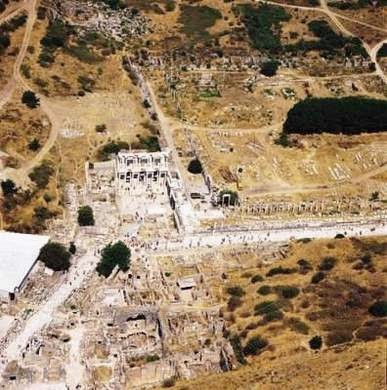 |
COMMERCIAL AGORA TETRAGON AGORA Being the most important trade center of Ephesus, Agora was built in the third century B.C in the Hellenistic Period, but the ruins date from the reign of Caracalla (211-217 A.D.) It is in the form of a square, each side 110 meters, and surrounded completely by columns. The Agora has 3 gates, one from the front of the theatre on the northeast, the other one opening to the harbor on the west and the third one from the Celsius Library. |
|---|
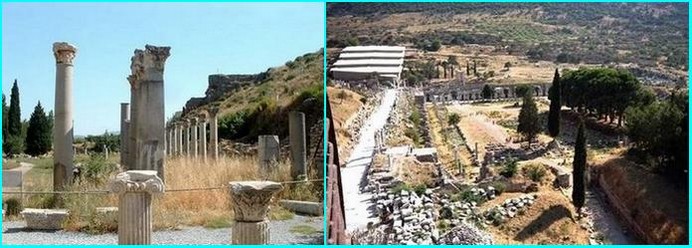 |
|---|
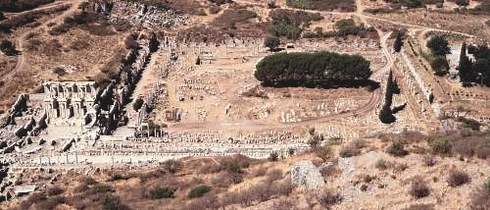 |
The north side of the Agora is left open, and the other three sides are surrounded by a portico, in which there are rows of shops. At the center of the Agora was a sundial and a water-clock. |
|---|
Commercial Agora in video 18.26- 1856->
 |
Excavations for AGORA - HELLENISTIc |
|---|
Isa Bey Mosque : Isa Bey Mosque is one of the most important works of the Turkish Aydin Emirate (Aydinogullari) who ruled in western Anatolia from 1308 to 1426. It was built in 1374 (776 A.H.) by Aydinoglu Isa Bey (1360-1390) in his administrative capital of Selçuk, near Ephesus. It is the second example of the twin-minaret mosques in Anatolia from the pre-Ottoman principalities period and is larger than many of the mosques of the time. Its architect was Ali bin Mushimish, from Damascus. The mosque was repaired in 1934 and restored later in the second half of twentieth century. |
|---|
 |
Isa Bey Mosque is situated on the southern slope of a hill overlooking modern Selçuk, just below the Ayasuluk Castle and the basilica of St. John. It consists of two main spaces, the courtyard on the north and the narrow rectangular prayer hall on the south, measuring about fifty-one to fifty-seven meters as a whole. The main entrance to the courtyard is from the monumental portal on its west façade, which faces the sea, close to the prayer hall. It is set on a slope with a double staircase that features a large niche with a fountain under the landing. The entry recess has a muqarnas vault with an umbrella crown and bears a finely carved inscriptive plaque. A smaller portal is placed on the east façade, in axis with primary portal and a third is centered on the north facade, facing the hill. |
|---|
 |
|---|
| The courtyard has an octagonal fountain at its center with twelve freestanding cylindrical columns on three sides that are all that remains of the courtyard arcade. Many of the columns are in bad condition with deep cracks. While the minaret at the southeast corner of the courtyard has not survived, the octagonal base and cylindrical shaft of the southwest minaret remains up to its muqarnas balcony. It is raised to the level of the roof, atop the heavy buttress of the main portal. It is accessed from an open staircase that wraps around the buttress. |
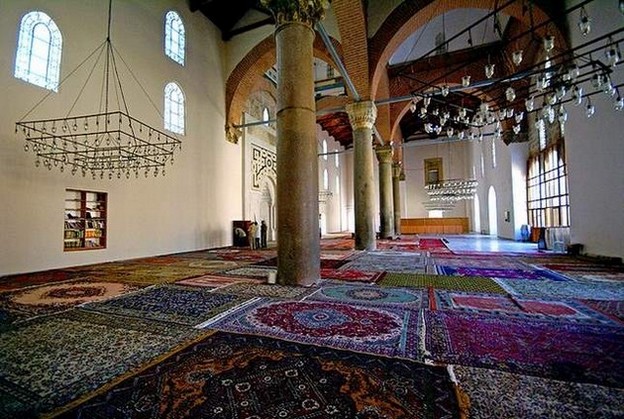 |
The prayer hall is entered from a triple archway at the center of the courtyard façade. The archway is crowned with two arched windows on either side of a circular window. Inside, the prayer hall is two bays deep and measures about eighteen by forty-eight meters. Two domes carried on brick arches and four granite columns surmount the two central bays of the entrance and the mihrab. The mihrab dome is slightly smaller with a diameter of eight meters. Three of the four columns have traditional stalactite capitals, while the other bears a Roman composite capital. The interior is illuminated from two upper tiers of arched windows placed at regular intervals. The courtyard walls are, similarly, pierced with arched windows, except for the east. The arched and rectangular windows flanking the main western portal are decorated with polychrome voissoirs and thick carved stone frames. The mosque walls are made of exposed rough stone, while the west façade is covered with fine marble panels and decorated with carved inscriptions, muqarnas and polychrome stone composition. Inside the prayer hall, the squinches of the mihrab dome are decorated with a mosaic of tiles with hexagons and star patterns in turquoise and navy blue. Plant motifs are also used in various decorations. |
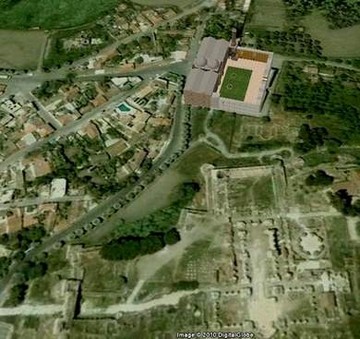 |
The stalactite carvings on the octagonal drum of the dome are in the Seljuk tradition. Some of the upper windows on the qibla wall are decorated with stalactite frames. Due to a long period of neglect followed by improper restorations, Isa Bey Mosque has lost many of its original properties. A door was cut through the qibla niche, and the muqarnas crown of the mihrab was removed to the Kestane Pazari Mosque in Izmir in the nineteenth century when the mosque served as a caravanserai. The mihrab niche was filled with stone masonry at a later date. |
|---|
Selchuks & IsaBey in video 41.20- 42.10->
BASILICA OF St JOHN It is believed that the evangelist St. John had spent his last years in the region around Ephesus and buried in the southern slope of Ayosolug Hill. Three hundred years after the death of St. John, a small chapel was constructed over the grave in the 4th century. The church of St John was changed into a marvelous basilica during the region of Emperor Justinian (527 -565 AD). |
|---|
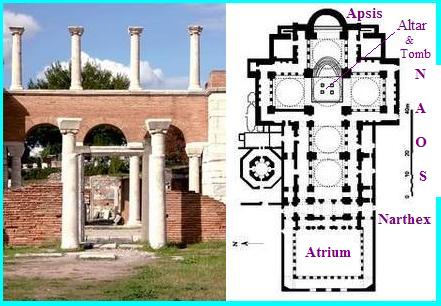 |
The monumental basilica was in the shape of a cross and was covered with six domes. Its construction, being of stone and brick, is an extremely rare find amongst the architecture of its time. Raised by two steps and covered with marble, the tomb of St John was under the central dome, that was once carried by the four columns at the corners. |
|---|
 |
The columns in the courtyard reveals the monograms of Emperor Justinian and his wife Theodora. Constructed in the 5th century AD, the baptistery is north of the nave, with its key hole shape. Rampart walls around the church were constructed for protection from the Arabian attracts in the 7th - 8th centuries AD. The impressive 10th century AD frescoes representing St John, Jesus and a Saint, ornament the chapel. With the invasion of Turks, the chapel was used as a mosque in the 14th century; unfortunately Basilica of Saint John became unusable due to the serious earthquake in the same century. |
|---|
St John or the Apostle John was the writer of the Fourth Gospel and the book of Revelation. The accounts of the Gospels agree that he is the son of Zebedee; together with his brother James, began to follow Jesus while fishing in the Lake Galilee. He became one of the Christs closest disciples and was with him on various significant events such as the Transfiguration and the Crucifixion. At his writings when Jesus was on his torture stake he said that : Mother, this is your Son. And to his beloved disciple, this is Your Mother(John 19 : 26 -27). The beloved disciple is thought to have been St John. The second half of the first century was full of persecution for the early Christians.Apostle James and Stephen were killed in Jerusalem.Paul was sent to Rome and executed. According to tradition John took The Mother Mary and came to Ephesus. He wrote his Gospel in Ephesus and the Revelation in Greece Island, Patmos in 96AD. |
|---|
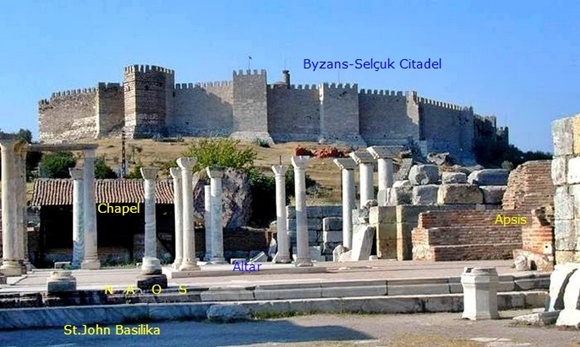 |
St. John the Evangelist probably remained at Jerusalem until the death of the Virgin, though tradition of no great antiquity or weight asserts that he took her to Ephesus. When he went to Ephesus is uncertain. He was at Jerusalem fifteen years after Saint Paul's first visit there [Acts 15 : 6]. There is no trace of his presence there when Saint Paul was at Jerusalem for the last time. Tradition, more or less trustworthy, completes the history. Irenaeus says that Saint John did not settle at Ephesus until after the death SS. Peter and Paul, and this is probable. He certainly as not there when Saint Timothy was appointed bishop of that place. Saint Jerome says that he supervised and governed all the Churches of Asia. He probably took up his abode finally in Ephesus in 97. In the persecution of Domitian he was taken to Rome, and was placed in a cauldron of boiling oil, outside the Latin gate, without the boiling fluid doing him any injury. [Eusebius makes no mention of this. |
 |
The legend of the boiling oil occurs in Tertullian and in Saint Jerome]. He was sent to labor at the mines in Patmos. At the accession of Nerva he was set free, and returned to Ephesus, and there it is thought that he wrote his gospel. Of his zeal and love combined we have examples in Eusebius, who tells, on the authority of Irenaeus, that Saint John once fled out of a bath on hearing that Cerinthus was in it, lest, as he asserted, the roof should fall in, and crush the heretic. On the other hand, he showed the love that was in him. He commended a young man in whom he was interested to a bishop, and bade him keep his trust well. Some years after he learned that the young man had become a robber. Saint John, though very old, pursued him among the mountain fastnesses, and by his tenderness recovered him. In his old age, when unable to do more, he was carried into the assembly of the Church at Ephesus, and his sole exhortation was, "Little children, love one another". He also brought Virgin Mary up on Panaghia Kapulu (Bülbül Dag, Nightingale Mountain) to protect her from the persecutions. |
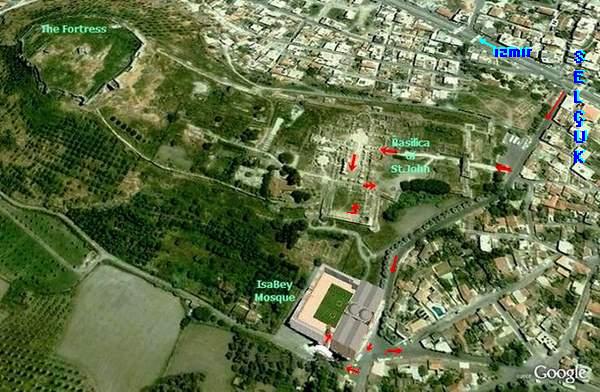 |
The date of his death cannot be fixed with anything like precision, but it is certain that he lived to a very advanced age. He is represented holding a chalice from which issues a dragon, as he is supposed to have been given poison, which was, however, innocuous. Also his symbol is an eagle. After his death he was buried nearby Ephesus. In the 4th century Byzantines build a small church over his tomb and finally in the 6th century Justinian I build a cathedral which was destroyed by the Arab raids between 7th and 8th centuries. Today his grave is recognized as a shrine by Vatican and it stands in Selcuk, nearby Izmir, in the Aegean region of Turkey. It is one of the many religious sites in Anatolia. |
Christianity & St.John & Mary & Duble Churche in video 33.50- 41.20->











